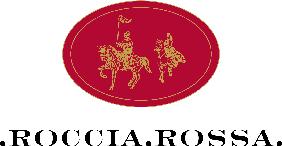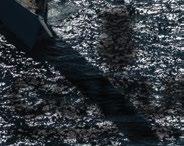


























A capital of design and fashion, an incubator of trends and a teacher of lifestyle, in a peculiar balance between excesses and sobriety, Milan has always been also one of the world capitals of jewellery. It is the hometown of major brands and at the same time the place where young talents, independent brands, and avant-garde productions continue to find their lifeblood, ready to blend with the city’s other great assets - fashion and design. Here, the second edition of the Milano Jewelry Week is preparing to “recapture” Milan after a two-year stop imposed by the Covid-19 pandemic. It will be an opportunity to rethink the function of jewellery and the spaces - not only physical - where to experience and contextualise it. After all, the question of spaces to inhabit, protect with more sustainable supply chains, and redefine with the conscious work of humans is one of the hottest in various sectors, from fashion and luxury to textiles and art, the first to venture with some ease into the unknown spaces of digital reality. A new reality that might confuse us in some ways but also makes us already feel part of the future, looking towards new beginnings, and inevitable new reflections.
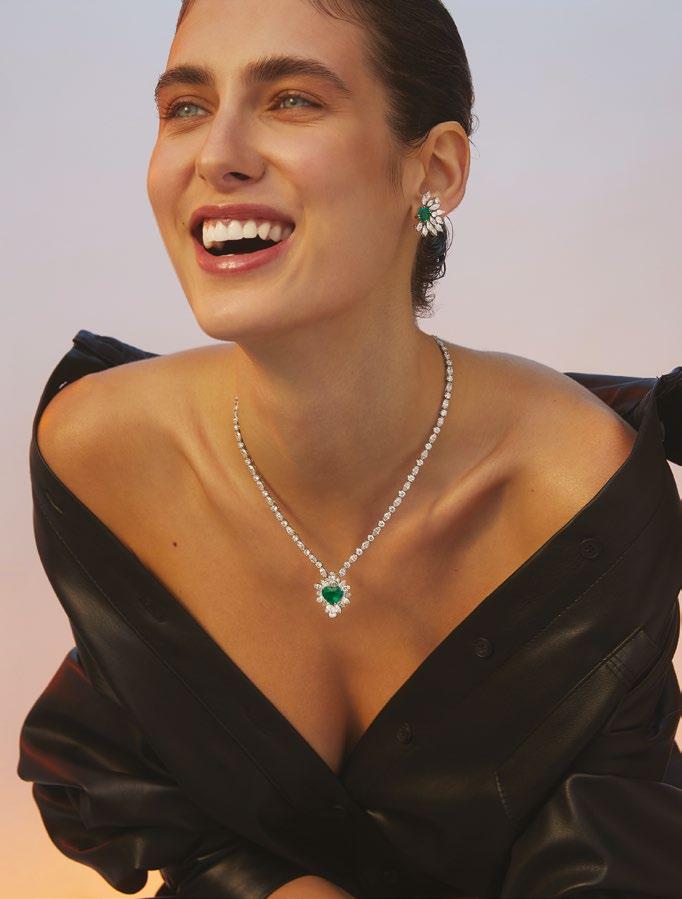
03 | Sept22
EDITOR-IN-CHIEF Vincenzo Carbone
EDITORIAL DIRECTOR
Domenico Festa
domenico.festa@huesersmagazine.com
EDITORIAL COORDINATOR
Antonella Garello
antonella.garello@huesersmagazine.com

ART DIRECTOR
Fabrizio Majerna
CONTRIBUTORS
Rosa Chiesa, Riccardo Ferrato, Didier Frevert, Ludovica Mereghetti, Davide Passoni, Samantha Primati, Donatella Zappieri
EDITORIAL OFFICE
NAVA COMUNICAZIONE
Via Friuli, 19 - 20135 Milano - Italy
CONTACTS
editorialstaff@huesersmagazine.com
HUESERS IS PUBLISHED BY
PRODES ITALIA SRL
Via Sansovino, 6 - 20133 Milano - Italy +39 02.36580208 info@huesersmagazine.com
ADVERTISING
adv@huesersmagazine.com
Italy
Barbara Pedone barbara@prodesitalia.com - +39 3286345142
Other Countries
Karen Tamayo karen@prodesitalia.com - +39 3517466115
PRINTED BY
Denona doo
Getaldićeva 1 - 10 000 Zagreb - Croatia
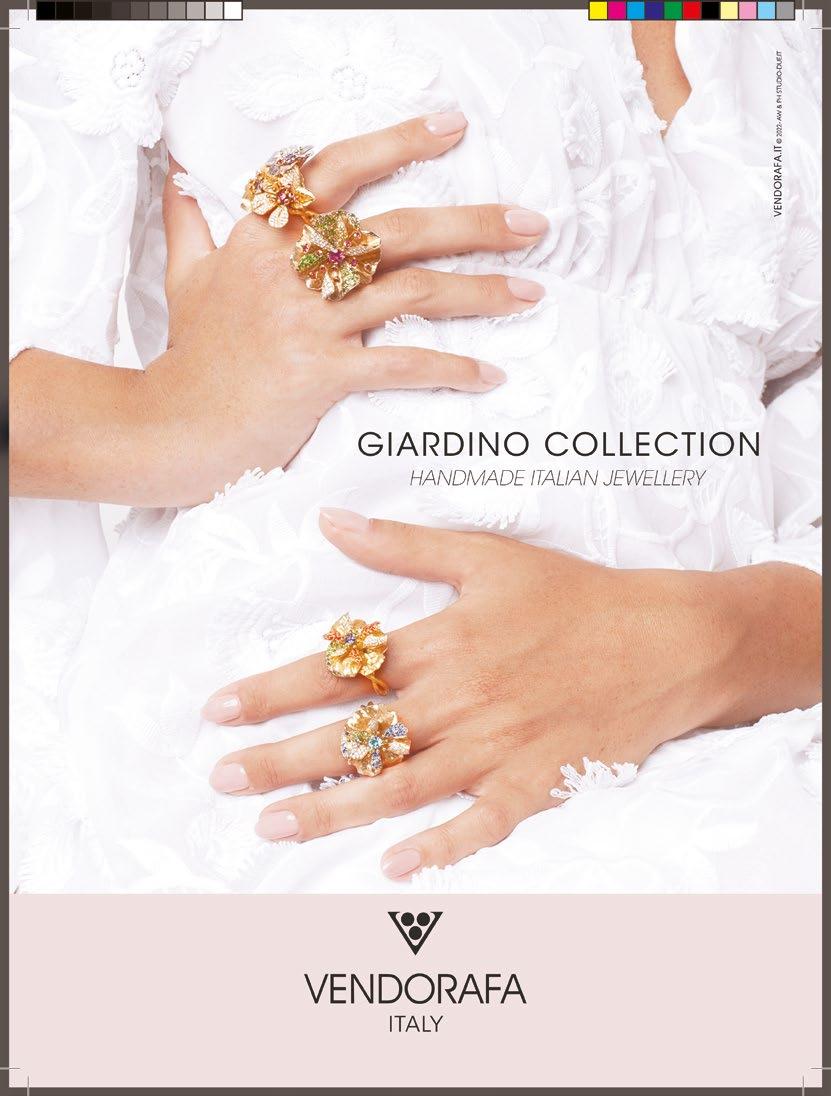

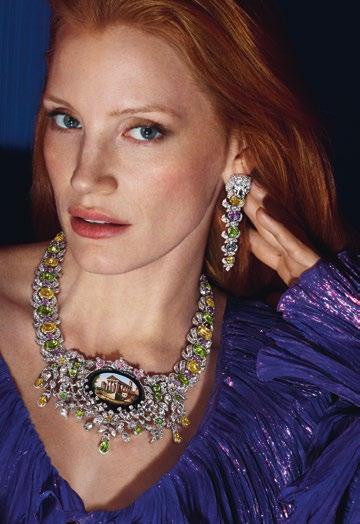








ASTA
18–27 ottobre 2022
CONTATTI
Gioielli
Leo Criaco
lcriaco@christies.com
+41 (0) 79 199 960 70
Orologi
Remi Guillemin
rguillemin@christies.com
+41 (0) 22 319 17 97
BRACCIALE ART DECO IN DIAMANTI

Stima: €15,000–25,000
Aste | Vendite Private | christies.com
Oltre al prezzo di aggiudicazione vengono applicate commissioni. Vedere la sezione D delle nostre Condizioni di Vendita in fondo al catalogo

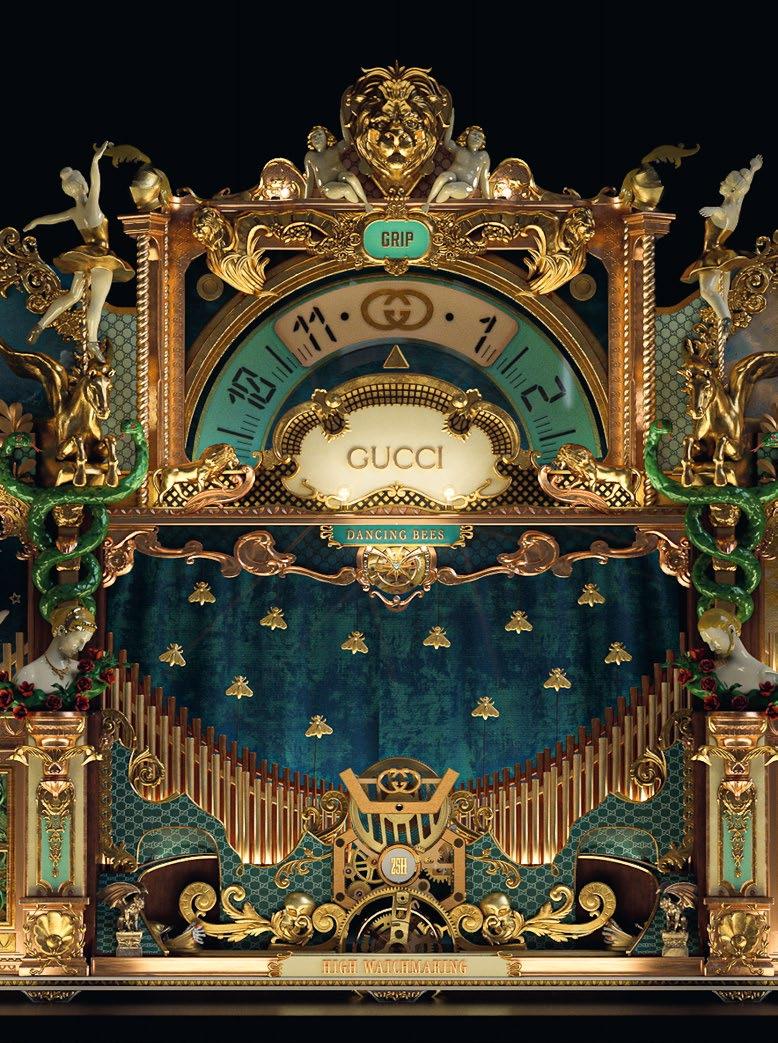 by Donatella Zappieri
by Donatella Zappieri
Following the House’s centenary, Gucci forges ahead into the next 100 years, continuing to redefine luxury, while celebrating creativity, Italian craftsmanship and innovation at the core of its values. Gucci is part of the global luxury group Kering since 2004. Gucci history starts in 1921 when Guccio Gucci establishes in Florence the eponymous brand aimed to produce leather goods, gloves and luggage. Guccio worked for many years in London at Savoy Hotel as bell boy and thanks to this experience he developed the understanding of English style and above all nurtured a profound love and passion for horses and horse riding, starting to be acquainted with brackets, clamps, saddles, bridles and the equitation world which still today plays such an important role in Gucci heritage.
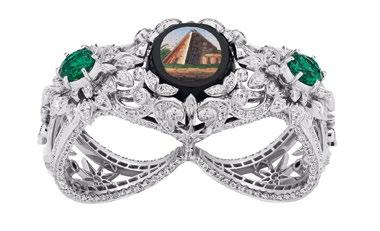
in Florence in 1921, Gucci is one of the world’s leading luxury brands, led by President and CEO Marco Bizzarri and Creative Director Alessandro Michele.
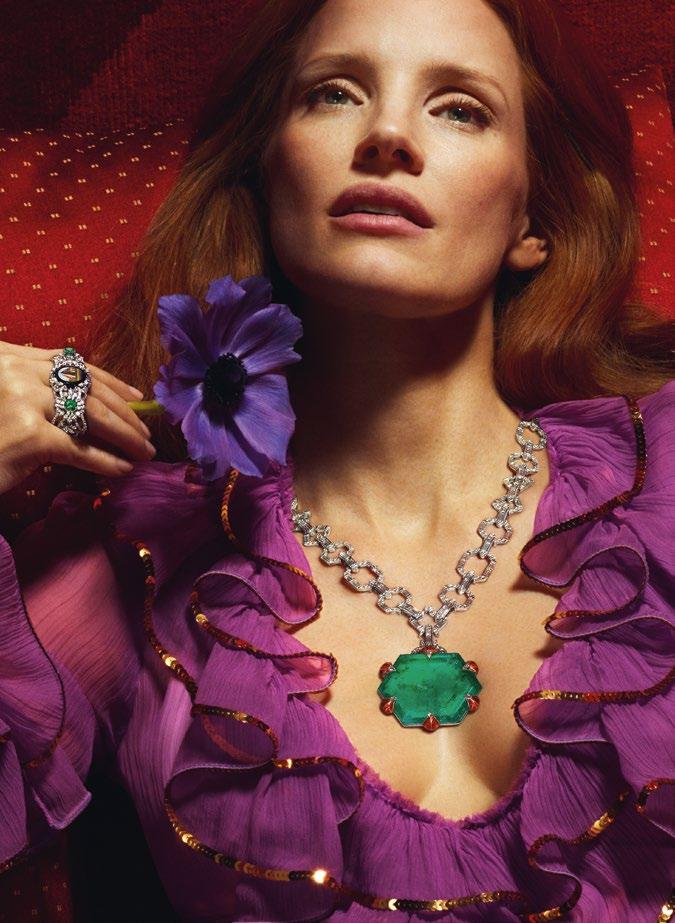
Already in the 30’s, many of Gucci’s customers are aristocrats with horse riding hobby and their request for clothing and accessories pushes Guccio Gucci to develop some of his still today very famous icons, for example the miniature of a horse saddle with a double ring held together by a barrette and the green-redgreen ribbon, reminding the typical saddles girths. In the 50’s, Gucci inaugurates the first store in New York in 58th street and this opening represents the American expansion and its international success. When Guccio Gucci dies, the house is left to his sons who contributed to further develop its success. In the 60’s and 70’s, Gucci collections start to be very well known because of their exclusive design and conquer many cinema stars and iconic people, bringing the brand towards a worldwide recognition. Hollywood stars such as Liz Taylor, Grace Kelly and later on the First Lady Jackie Kennedy opened the doors to Gucci
success also in Asia. At the end of the 80’s, the house is sold to Investcorp to be then acquired in 2004 by Kering Group.
Since 2015, Alessandro Michele is the Creative Director and since his appointment he has been pushing the boundaries of aesthetics hence always re-exploring and enhancing the brand heritage and its iconic elements. He has been able to create a universe mixing femininity and masculinity, past and innovation thanks to collections which are post gender and at the same time infused by elements of Renaissance, gothic and fairy tale. By simply following the #gucciCommunity you will soon realize that for Alessandro Michele creativity is a moment of escape but at the same time a sign of solidarity and kindness, a message shared by the many artists, talents and activists guided by his artistic direction.
In the last few years, Gucci has enriched its collections with a deep dive into the codes of high jewelry and high watchmaking in order to answer to the strong request of international clientele who is intrigued by the brand’s stylistic codes and wishes to enjoy their evolution also in the universe of super precious and exclusivity of one of a kind creations. The latest High Jewelry collection was presented in Rome last June whereas the High Watchmaking collection had been unveiled in Geneva in April during Watches and Wonders days.
For both presentations, uncommon locations were selected: Villa Albani for jewelry and a private villa for watches.
Enriching Gucci vocabulary with a fairy tale and gothic lexicon, with this new high jewelry collection, the third of Hortus Deliciarum (Garden of Delights) collection, Alessandro Michele was able to create a rare and coherent

design language, a summa of all codes which we find in the Maison clothing and accessories, with the aim to imbue each jewel with poetic as well as social values. The High Jewelry collection draws on the symbolic motifs that are dear to Alessandro Michele and Gucci, taken from the extensive and multifarious canon of the House’s iconography. A collection of memories, made of unique pieces divided into five themes, a creative ode to specific historical and architectural eras suspended in time and space. The journey is inspired by the Grand Tour and reveals romantic, maximalist jewels made with mastery. Like a passionate collector, Alessandro Michele writes an allegory that holds within dreams, experiences, stories and secrets showcased within the five chapters of a travel diary in the shape of “souvenirs in the form of a jewel”: a collection of memories where micro mosaics, gems of pure rarity and exceptionally skilled manufacturing embrace in a narrative which is never understated but, on the contrary, plays with unexpected and sophisticated manufacturing techniques.





To evoke the narrative behind Alessandro Michele’s third Hortus Deliciarum High Jewelry collection, Oscar-winning American actress and film producer Jessica Chastain plays an eclectic collector of mementos and memories. Shot by Mert & Marcus in the film and photographs, a peek into the protagonist’s home reveals an opulent trove of souvenirs accumulated throughout her life’s travels. Mimicking the splendor of a voyage, these special items, masterfully crafted with precious gemstones including emeralds, aquamarines, opals, and rubellites, tell stories and secrets of faraway places.
Gucci is a certified member of Responsible Jewellery Council (RJC) and among its missions the brand promotes responsible practices from an ethical and environmental point of view.
When it comes to High Watchmaking collections, to fully appreciate these specific product launches we have to date back to 1972 when, in the watchmaking heartland of La Chaux-de-Fond, Gucci presented the world with a new horological design proposition - watches

combining unparalleled Swiss technical knowhow with the best of Italian design. In 2021 Gucci made its long-awaited debut in high watchmaking with a series of Swiss made designs showcasing technological flair, noble materials and unique decorative artistry. 2022 in Geneva marks the 50th anniversary with a collection named Gucci Wonderland. Once again, the mood of this kaleidoscopic collection is inspired by a magical fairground, where the most refined watchmaking complications appear alongside rainbow-like gems and celestial wonders.
Both High Jewelry and watches launches represent an additional statement of Alessandro Michele’s creative vision bringing the viewers and customers into an artistic gothic fairy tale where heritage, savoir-faire and innovation perfectly merge together creating a magic and sophisticated imaginary world.








 by Antonella Garello
by Antonella Garello
- Pasquale Bruni was just over twenty years old when he founded his first jewellery company in Valenza, Gioielmoda - the Pasquale Bruni brand immediately stood out for uniqueness and quality craftsmanship, and is today an international symbol of Made in Italy excellence, loved by prominent personalities such as Michelle Obama, Lady Gaga and Amal Clooney.

It is present in over 30 countries and on important international digital platforms. Yet, says Eugenia Bruni, daughter of the brand’s founder and Creative Director since 2001, the company philosophy has remained that of an artisan laboratory, where everything is still driven by passion and shared values.
When did you realise that your future would be in jewellery?
The environment in which I grew up and my father himself, a great teacher I have always admired, had a huge influence on me. Since I was a child I experienced life in the factory for what it really was, without idealising it. I loved it unconditionally from the very first moment I set foot there, as a little child. The factory was immediately my place of choice: I felt at home, protected there. My real life was there. The extraordinary thing is that, after so many years, nothing has changed: for me, our atelier is still a place of wonders, where I feel alive in the creative process with our artisans, whom I’ve always considered family. Together we develop energy that makes me feel good.
So you learned directly by working in the company?
Everything around me contributed to my
training and made me fall in love with this industry. I had a well-rounded education. I have always favoured design and the creative part of work in general. Still, my father always pushed me to experience every facet of the company, dealing with sales, trade fairs, and customer relationships... On a more personal level, I learned to “feel” the gemstones, to understand their beauty and energy not through a school but by being in contact with them. Gemstones have accompanied me throughout my life journey and in becoming a woman. They loved me, cared for me, and made me a better person... I’m saying all this because my approach to jewellery was, first of all, a very intimate process, which still excites me a lot. Of course, my long stays abroad also helped me to have a broader cultural vision. All this is then reflected in our creations, as our jewellery brings with it different cultures, sensibilities and women’s worlds.
Nature has always been my great source of inspiration, the greatest teacher of shapes and creativity; it is the finest source of emotions and inspires us to live in profound gratitude towards creation. It is no surprise that the bond between women and nature is so close and powerful. Nature makes us free; it allows us to understand that we can be reborn several times even in this life, admire the beauties of creation, and rediscover ourselves. It is always tricky for me to explain how our jewellery is created. It is a highly elevated moment that we would like to become part of people’s lives: it is the moment in which you can communicate with nature and genuinely understand the wonder of a leaf, its sinuosity, its elegance, the sense of a flower and how it blossoms… To create means to connect with something higher, spiritual.
What values does Pasquale Bruni jewellery aim to convey?

Our first goal is to be able to communicate emotions. That’s why ethics for us is a thorough commitment: we have converted most of our materials into sustainable materials and are members of the Colour Gems Ethical Committee. Our gems are all traceable, and diamonds meet the Kimberley Process requirements. We have also started collaborating with the NGO One Tree Planet, which will plant new trees for each jewellery piece we sell. And, of course, it is also ethical to make quality items designed to last over time. For me, jewellery is not inert matter and, if it is made with dedication, passion and love, it will be able to convey positive emotions to those who wear it.
Do you monitor every stage of the jewellery manufacturing process?
Of course. All our jewellery is made in Valenza.
I am in charge of creative direction and have always worked side by side with our artisans: I like to say that we never leave our jewellery alone! Each piece is the result of extensive research on both shapes and gems: our jewellery must feel like a hug and women should feel this embrace on their skin as a form of love, with all the energy of gemstones. We often use stones related to the heart chakra, emotions, water, and feminine elements. Nothing is accidental in a Pasquale Bruni piece.
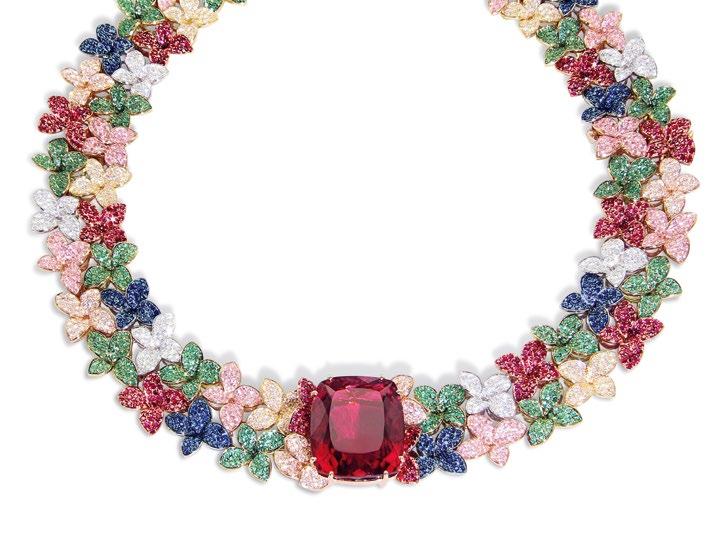
Is there any common thread in your new collections too?
In general, our new collections are inspired by a search for light. The new Giardini Segreti (Secret Gardens), for example, play with the contrast of black and white diamonds, and there is special care in the pavé through which these two worlds chase each other, day and night, so that women can always see the light, even in the charm of the dark. In our Ton Joli lunar jewellery, I used a lot of moonstones. They are gems with particular transparencies that accompany the woman on an inner journey toward the light. In my jewellery, they chase each other to compose flowers, lace and embroidery in a dance that leads the woman to enter a beautiful lunar universe, almost transfigured by this light. Some other jewellery pieces feature gold forms, and the heart is the gem: they represent a hymn to nature and Tara, the mother goddess of Tibetan Buddhism.
How much have lockdowns and pandemics influenced this search for light?
Spirituality has always been an essential part of my jewellery, mysterious but present. However, during the pandemic, everyone got closer to the most spiritual part of themselves, and the time has come to reveal and share the emotions that have always been inside of us, but we were not as aware as we are of them today.
For Pasquale Bruni, luxury is not just about precious materials but also research, ethics, interconnections and spirituality. Is it true that you have been practising meditation for years?
I always have, for as long as I can remember. Meditation is entering into a relationship with myself; it is my secret garden: when you can connect with yourself and your soul, you can embrace the entire universe. Meditating has also helped me immensely in the creative process; through meditation, you can heal yourself with your inner light and share the light with others; jewellery is a tangible messenger of this gift.




 by Antonella Garello
by Antonella Garello


Mario Buccellati initiated what would become one of the most prestigious jewellery brands of all time. Very young, he lost his father and his mother moved the family to Tromello from his native Ancona. He finally reached Milan and Milan welcomed him in the early 20th century, a period of transformation and development that would make the city Italy’s industrial and economic capital. Mario contributed to the city’s creative culture; as an apprentice, he joined the renowned Beltrami & Besnati jewellery store on Via Santa Margherita, a few steps from the La Scala theatre, and fell in love with the goldsmith’s art, instantly showing his extraordinary talent. The story of his beginnings is also out of the ordinary: he returned to Milan from the First World War (with a war merit cross), purchased the jewellery store on Via Santa Margherita and started his own business in 1919, with his first creations rapidly becoming a success. Mario Buccellati was inspired by classical artefacts, particularly from the Renaissance. He reworked them with original chromatic and technical solutions, which have remained unmatched in creativity and perfection. The complex “tulle” and “rigato” techniques became his unmistakable signature; engravings and chiseling created refined jewels, looking like lace and fabrics studded with precious gems. In 1921, during an exhibition in Madrid, his pieces caught the attention of Spanish royalty and made him famous on the international scene. The following year he met Gabriele D’Annunzio. The poet became his good friend and fervent admirer (he crowned him “Prince of goldsmiths” and nicknamed him “Mastro Paragon Coppella”, referring to the small crucible used by goldsmiths) as well as an enthusiastic customer who bought hundreds of jewellery pieces and accessories. He donated them to friends and lovers, celebrities such as Eleonora Duse and Ida Rubinstein or simple strangers, becoming an exceptional brand ambassador. Buccellati jewellery was now sought after by royal houses and by affluent and prestigious customers across Europe. A wise entrepreneur and a great artist, Mario Buccellati opened boutiques in Rome and Florence a few years later. At the same time, at the beginning of the 1950s, he pioneered the American market with the help of his son Luca, opening two stores in New York and Palm Beach. It was also successful abroad, and the “Buccellati style” became a symbol of refined Made in Italy quality. Mario Buccellati died in 1965, leaving five children: the youngest, Giorgio, would become a famous archaeologist; the other four - Luca, Lorenzo, Federico and Gianmaria - separated

The Buccellati family has been able to innovate from generation to generation while remaining true to its history, reinterpreting the codes and techniques of the past with creativity. For over a century, the Maison has continued to make creations with timeless charm and refinement.

after a period of shared management of the family business. In 2011 Gianmaria realised his dream of bringing the Gianmaria Buccellati and Mario Buccellati companies together under a single brand - Buccellati. Gianmaria, who on Mario’s death had become responsible for the craft workshops and the creative part, inherited not only the great talent of his father but also his entrepreneurial spirit. He expanded Buccellati’s business and prestige worldwide: in 1970 he inaugurated the first Italian jewellery in Hong Kong (Tokyo, Osaka and Nagoya will follow in Japan), and in 1979 he was the first Italian jeweller to open a shop in the legendary Place Vendôme. Headed by Gianmaria, who passed away in 2015, Buccellati made headlines for the extraordinary masterpieces created


by the Maison’s artisans and for their ability to innovate the brand’s tradition without ever betraying its spirit. They expanded the brand’s range to include watches and unique accessories (such as the most expensive iPhone cover in the world, designed in 2014 by his granddaughter Lucrezia). Ambassador of the highest goldsmith art worldwide, he also did a lot for the jewellery industry in Italy, cofounding the Italian Gemmological Institute in 1973, which he would head for 25 years. Globally admired for his skills as a goldsmith and an entrepreneur, he has been a Famedio member in Milan since 2018. In the best family tradition, his son Andrea supported him from a very young age, learning all the secrets of the Buccellati processes and techniques and passing them on to his daughter Lucrezia. The Richemont Group has owned Buccellati since 2019, but the family has maintained key roles:
Maria Cristina is the head of communication, while Andrea is the honorary president and creative director. He works hand in hand with his daughter Lucrezia, the company’s first female designer and representative of a new generation, capable of giving new creative impulses and reworking Buccellati’s great style heritage in a new way. Many initiatives in recent years have demonstrated the jewellery brand’s vitality and deep bond with Milan. In 2019, the brand’s 100th-anniversary celebrations culminated with the opening of a new, prestigious headquarters designed in 1919 by architect Portaluppi. In 2021, participation in the Homo Faber event showed the cultural bridge that continues to unite Buccellati with the more cultured Renaissance tradition and the challenges of the 21st century. The company also took part in the Design Week for the first time. They did so in style, with the exhibition
“Il Galateo - a Journey into Conviviality”, curated by Federica Sala and set up by Studio Stefano Boeri Interiors. They asked four leading names in design (Dimorestudio, Ashley Hicks, Chahan Minassian and Patricia Urquiola) to provide their own take on the contemporary table using Buccellati silver collections and the new porcelain collection developed with Ginori 1735, which reproduces the decorative motifs of Buccellati’s Double Rouche collection. Inspired by Giovanni Della Casa’s Galateo and Baldassarre Castiglione’s Il Libro del Cortegiano, Buccellati wanted to celebrate the table as a privileged place for the pleasure of being together, which we have missed so much in the last years.
Finally, recent initiatives include participating in the Haute Couture week in Paris, where Buccellati exhibited unreleased pieces from the Vintage collection, a revival of masterpieces created between the forties and the nineties. The collection is the result of meticulous study and research that led to an archive of over 20,000 original drawings, 500 plasters and more than 6000 photographs: a dip into the history of this legendary company that will delight admirers and collectors.





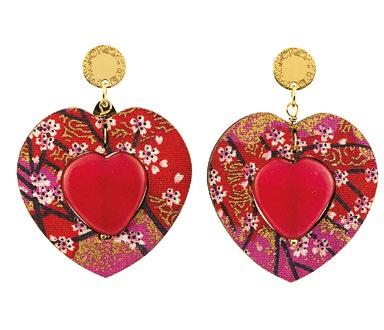



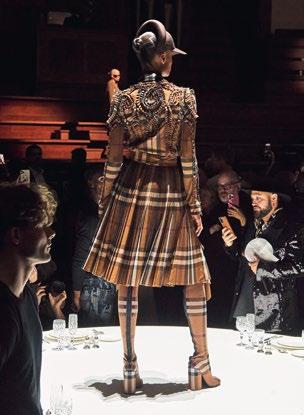
A magical mix of newness and tradition, elegance and irony, garnishing and severity. A contemporary version of the woman who would have lived in Gio Ponti’s Milanese interiors.Burberry Fall/Winter22 Molteni
How would the woman who lived in the spaces designed by Gio Ponti dress today?

Those places that belonged to Milan in the 1960s, an authoritative and sober city. It is not difficult to imagine this female figure thanks to some of the designer’s typical and unmistakable traits. And they make him a contemporary figure, a twenty-firstcentury artist. Gio Ponti had a great gift; he could involve all levels of design: from the smallest items to great architectures, with his sophisticated, democratic, understated and incredibly modern touch.
Just as sophisticated as his D.153.1 armchair (still produced today by Molteni), a piece of furniture in Gio Ponti’s private home on Via Dezza. Just as sophisticated as the Hermès woman today; sober and daring, she knows how to perfectly dose her sensuality when she alternates black leather with voile on textured dresses or when she wears a fancy piece of jewellery without falling into futile, superfluous luxury. She is beautiful in her cultured demeanour.
‘Democratic’ is not an adjective that can be easily applied to a way of dressing, but it is when it comes to wearable fashion. Democratic, the D.357.1 bookcase can be added to any residential context. This object adapts to different situations without looking inadequate but enhances the room where it is placed with its simplicity. Dior’s bag is also democratic, and so are Marni’s minimal bracelets. Or YSL slingbacks, rock and sober, depending on the woman who wears them.
The Ponti woman today is democratic because she knows how to choose from a wide range of pieces accessible to everyone and adjustable to the wearer’s attitude. Sobriety, on the other hand, makes the overall style of this contemporary woman different. Sober was every project that came out of Ponti’s pencil. We must not think of it with a negative meaning; sober is not a byword for boring, grey, or sad. When it comes to sobriety, it is curious to explore the Greek etymology of this term, which links the word to the concept of ‘intellectually balanced’. And here lies the key to understanding this woman’s style, showing sobriety in being self-centred, extremely aware of what she can wear and how to do it without using uniforms to hide frustrations or complexes. Even when she ventures into a checked total look or a macro trench turned into a Burberry evening look, she appears magnificently unique. And

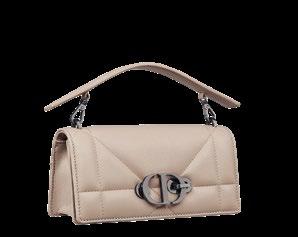
modern. Just like Ponti’s creations. Every item, piece of furniture, and building by the great designer looks like they were designed today. Gio Ponti’s irresistible lightness projects his immense work over time. That art makes the Pirelli Skyscraper, the Palazzo on Via Dezza in Milan look as if generated in an infinite time. As is Stella McCartney’s leather dress. It could have been designed by an art deco stylist or by a future fashion student. You can’t know, and asking yourself may not even make sense. Because ‘art is the most resistant material’ - Ponti used to say - and beauty lies in the ability to recognise it, even when choosing a dress to wear. And the Ponti woman knows it well.








With a Spanish heart and a cosmopolitan soul, PDPAOLA has made its way into international markets in just a few years, with simple but effective style choices that have made the brand recognisable and popular. Founded in Barcelona in 2014 as the brainchild of siblings Paola and Humbert Saspligas, PDPAOLA has been able to keep up with fast-evolving trends and a succession of ever-new fashion jewellery brands. Minimalist, essential lines are the brand’s style signature. Their simple, clean designs stress the importance of being yourself and showing yourself the way you are, without masks, bold yet vulnerable. PDPAOLA jewels can tell your story through a few simple elements capable of enclosing even the most important messages. The Juno line, for example, celebrates women and nature as creative forces. Motion jewellery contains an energy flow that seems to regenerate itself with every movement in fluid and hypnotic lines. The Charms collection transforms letters, numbers, objects and natural stones into authentic amulets. Finally, the Super Future line represents futuristic visions, an escape from everyday life with spheres for future prediction and micro robots. Essential and genuine: these two features seem to be the winning key of a brand that closed with a 30 million Euro turnover in 2021, marking a +25% compared to 2020. These achievements result from a consolidated distribution network that boasts 2,000 stores in over 10 international markets and plans to expand with new flagship stores in the coming years. Among reference markets, Italy is undoubtedly one of the most relevant, with a turnover of 2.7 million Euro in 2021 and a digital and physical presence guaranteed by the distribution agreement signed with Diffusione Orologi. Initially limited to silver jewellery with gold or rhodium plating, PDPAOLA products have evolved over the years following the tastes and demands of a clientele attentive to the latest trends and the hottest global issues. In 2021, the brand debuted with Fine Jewellery, its first jewellery collection made from 100% recycled 18 carat gold. In 2022, PDPAOLA also launched the Sustainability Page online, a website section dedicated to the Sustainability Plan developed by the brand, the goals achieved and the initiatives undertaken in recent years.
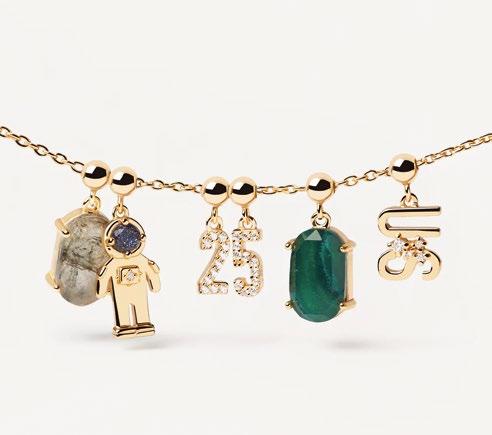
We can tell your story through a few simple elements capable of enclosing even the most important messages.



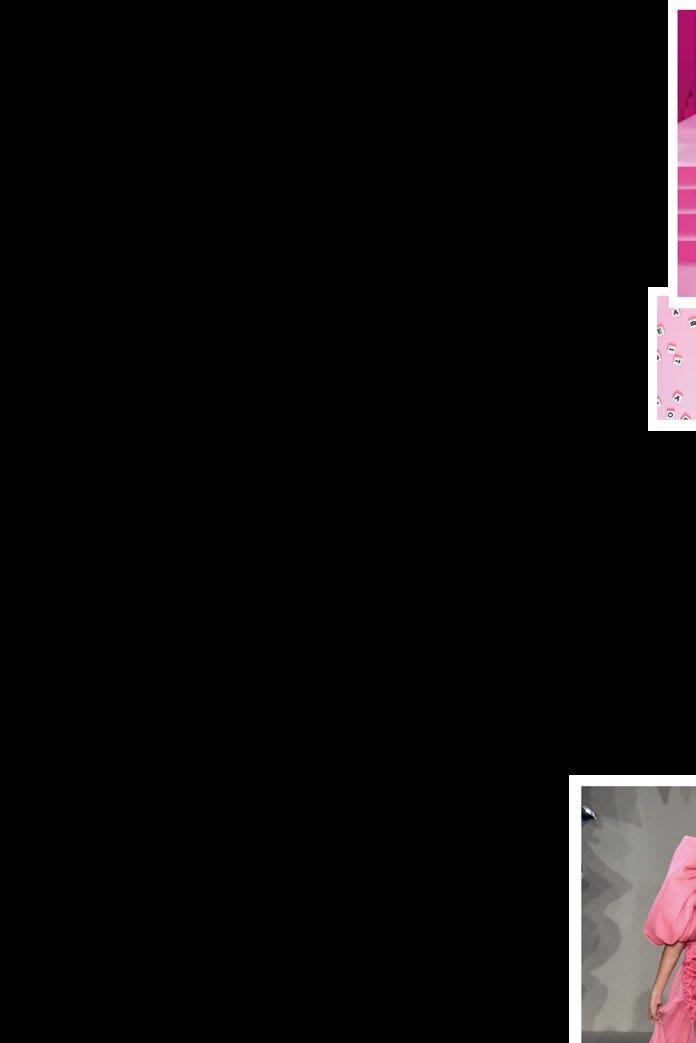 by Samantha Primati
by Samantha Primati
I love pink! It is the new fashion obsession for fall winter. From fuchsia to chewing gum, from powder to fluorescent tones, pink will be the color to bet everything on. Valentino proclaims it loudly.
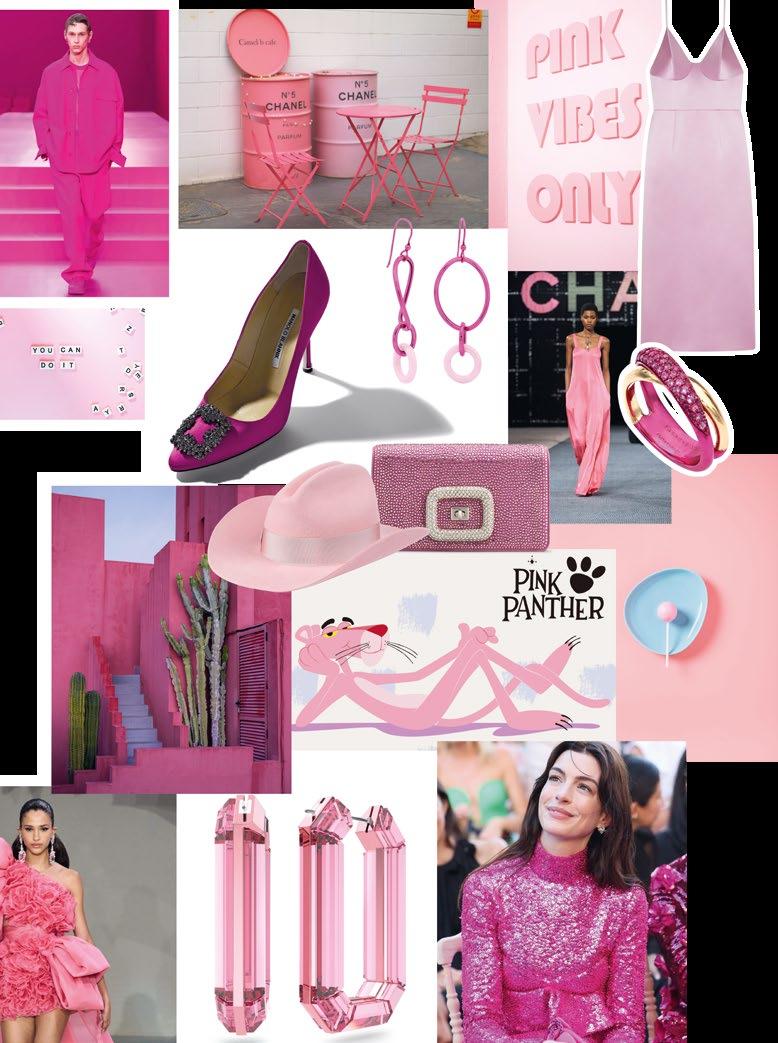

The Style of Black. Only black is always capable of overcoming itself to return cyclically to fashion, filled with austerity and sensuality. Because in the twinkling of the eye, black is always seductive even when pervaded with nihilism.

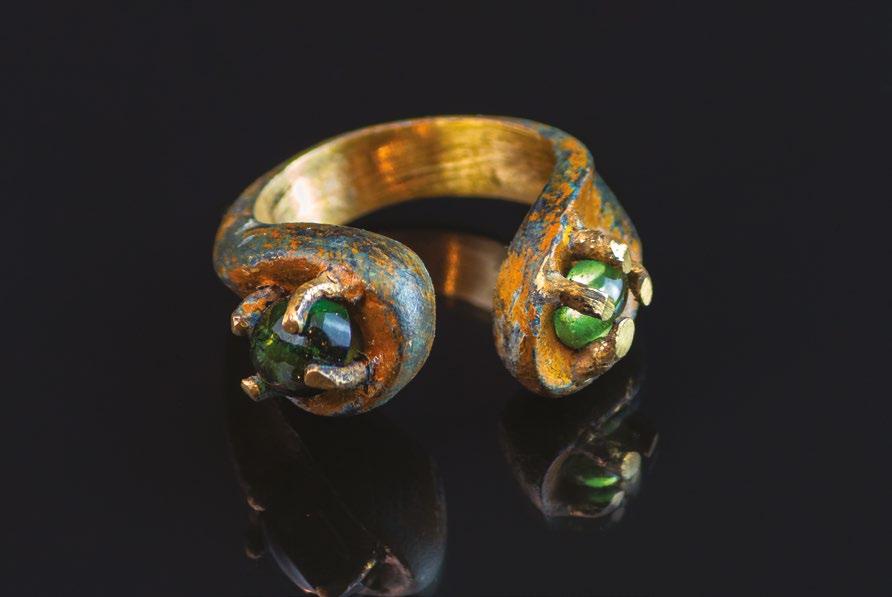






 Page alongside: earring by Alessio Boschi. On this page: earring by Leo Pizzo.
Page alongside: earring by Alessio Boschi. On this page: earring by Leo Pizzo.
On these pages:
 necklace by Cielo 1914.
necklace by Cielo 1914.
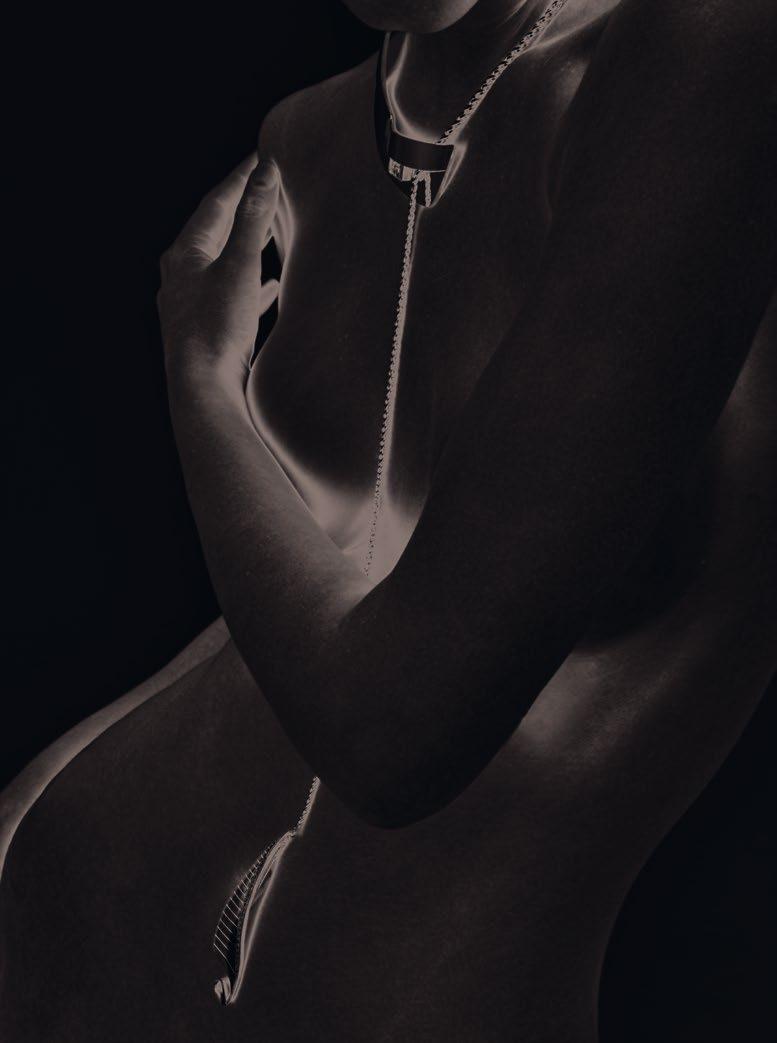
 On this page: necklace by Carmen Tapia. Page alongside: earring by Ying Chen Chen.
On this page: necklace by Carmen Tapia. Page alongside: earring by Ying Chen Chen.


 Page alongside: rings by Mada Jewellery. On this page: hairpins by Armiss.
Page alongside: rings by Mada Jewellery. On this page: hairpins by Armiss.
 On this page: ring by Gilli. Page alongside: bracelet by Antonini.
On this page: ring by Gilli. Page alongside: bracelet by Antonini.
 by Donatella Zappieri
by Donatella Zappieri
Katerina Perez discovered her appreciation for fine and luxury jewellery while working in the retail environment for Tiffany & Co., Chaumet, Asprey and Boghossian and today, as a very well-known jewellery insider, her interest in and passion for the art of jewellery has only strengthened with time.

Katerina is a jewellery expert and connoisseur, journalist and brand consultant with more than 12 years’ experience in this industry. Her reputation is international and you can spot her in most of the jewellery related shows and events around the world. Russian-born and Paris-based, Katerina has worked as a freelance journalist and content editor since 2011, writing articles in both English and Russian for international publications, including Vogue Arabia, VO+, Robb Report, L’Officiel, the Natural Diamond Council and Kommersant. Katerina founded her own website – katerinaperez.com – and launched her Instagram platform in 2013 and has, since then, become one of the most highly regarded and authoritative influencers in the fine jewellery space. She is hailed as being one of the first writers to bring high jewellery online, combining her own impressions and opinions of new collections with jewellery trends, watch insights, colored gemstone stories and original photography. Much of all this photography and her distinctive touch are to be found on Katerina’s Instagram profile@katerina_perez - which provides a community of more than 400,000 jewellery lovers, customers, brands and designers. Drawing on this knowledge of engaging and entertaining a global following, Katerina regularly works as brand consultant, collection curator and educator to offer bestpractice guidance to the jewellery industry. Katerina has also launched her own “academy” through online courses where she supports and helps brands and designers to create content, engage their audience and grow their accounts. She has been recognized in trade magazines and the consumer press in publications such as The New York Times, L’Officiel, Tatler, JCK and The Financial Times. She has also served as a guest panelist, lecturer, judge and keynote speaker at various international events, including Vicenzaoro, International Jewellery London and COUTURE Las Vegas and has delivered educational talks at the Gemological Institute of America (GIA). In 2021, she was presented with the World Influencers and Bloggers Association (WIBA) Award for Jewellery Influencer of the Year. What is extraordinary is that, even with this ongoing success, Katerina has never lost sight of her mission to make as many women as possible fall in love with jewellery, just as she did, and to show her readers and followers that jewellery is an art form, not merely a form of self-adornment. When you meet her in person she is always extremely helpful, eager to share her passion and she also has an excellent way to motivate young students in finding their right approach towards social networks.
We met her recently during Haute Couture week in Paris and discovered a bit more about her background, passions and interests.
When and how did you start your activity?
I actually started when I was working in retail and my clients who came to buy a jewel asked me how much a piece of jewellery is and how many carats of stones there were. But you all know too well that there are so many other factors that affect the price! So, I was sharing different bits of knowledge with my clients, often by email and then they started saying that they love the way I write... that really surprised me and gave me the boost of confidence needed to start writing online.
You are among the top jewelry influencers, how would you define your distinctive sign?
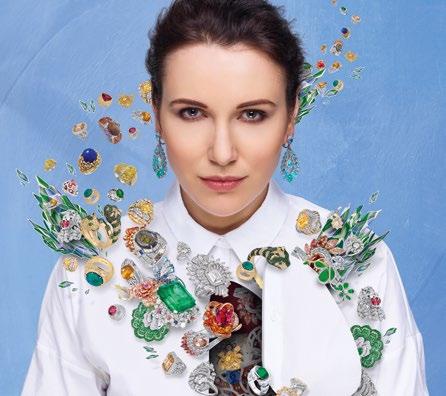
My personal signature can be traced in the type of jewellery that I curate and the way I talk about my jewellery discoveries. When I started writing about jewellery, it took me a couple of years to shape up my taste and now I know that it is design-lead jewellery with coloured gems. If you show me a huge diamond, I would appreciate it but it won’t stay engraved in my memory while spectacular designs will. I also like to talk about design, inspirations and stories behind the jewels, hoping to educate more people about all things precious.
How do you see the evolution of social media and in which way are you shaping your activity to meet with those changes?
Social media function differently these days, they are becoming more and more demanding and if we talk, say, about Instagram, it combines a few different apps in one. Before posting a photo accompanied by a caption was enough. Also, the space becomes more and more saturated with jeweler accounts and it becomes harder to stand
out and grab attention, but creative jewellers use a lot their imagination and succeed at it!
You have a vast community of followers, how would you describe them?
I am followed by a wide variety of people including industry professionals and end consumers.
How do you cope with the everyday activity and your personal life as you also manage different accounts?
It’s all about discipline, planning and delegation as well as having a wonderful team by your side to help! Managing social media, just like our personal life, is not as easy as it requires much planning and delegation. To balance personal and professional life I work office hours when I am not travelling.
Is jewelry your only passion or can you unveil to our readers others?
I often say that if I was not writing about jewellery already, I would be blogging about designer handbags. I can’t explain exactly why I love them, but I am always interested in bags with elegant forms and interesting details.
What is next in your career? Can you share with us some of the next projects you will be working on?
In 2023, I will be celebrating 10 years of katerinaperez.com and my career as a jewellery KOL, so some events and exciting news will be revealed soon!
So, let’s look forward to this important anniversary and we will stay tuned to discover what this will all be about.

 by Davide Passoni
by Davide Passoni
Roots remind us of where we come from, and, for a company, they often coincide with the family that founded it and the city where its entrepreneurial history started and grew. Binda Italia and Milan are one of these perfect combinations.

The story began in 1906 in a small town on Lake Maggiore, Besozzo, where the twenty-year-old Innocente Binda opened a shop to repair and sell watches. Twenty years later, he moved to Milan, and the family’s history has been intertwined with the city’s ever since. “The bond that unites Binda to Milan is solid and has lasted for over 100 yearssays CEO Marcello Binda - The three generations who have led the company throughout its history have lived in this city, have breathed its atmosphere and soaked up inspirations and influences. Milan has transferred a passion for design, a love of glamour and fashion, curiosity and a drive for innovation. Every Binda creation would have been different in another context and city. This is the only place where you can experience certain emotions and feelings”. Thanks to an ability to evolve by following and anticipating trends, and to express passion through innovative quality products, Binda Italia has developed a distinctive style by interpreting and sharing emotions, as emphasised by the brand’s catchphrase ‘Designing Emotions’, created for the company’s 100th anniversary and still powerful today.
These emotions speak mainly of watchmaking and micromechanics: “Since I was a child, I have been surrounded by watches - Binda continues - the family business has allowed me to appreciate and get

“There are two lasting things we can hope to bequeath to our children: roots and wings”.Marcello Binda
to know this magical and fascinating world in depth. And as a man, I can say that the watch is still the first and most important accessory that adds a touch of character to a person’s look and personality. So my passion could only be for this product category”. Within the group, the watches are mainly attributable to the Breil brand, whose first timepiece dates to 1935. Since then, the brand’s collections have featured sophisticated aesthetics and careful research at every stage of the creative process. The brand presented the Manta collection in 1978, its first truly iconic collection. The 1990s marked the beginning of a new era for the company, with a young, flexible, lean and marketing-oriented structure. The 1994 ‘don’t touch my Breil’ campaign permanently fixed the brand in the minds of consumers.

“Italians have always perceived Breil as an international brand, born abroad - says Binda - Perhaps also because of its name, which derives from a Swiss town where my grandfather Innocente would often go. It was not until the last few decades that the concept of Italian quality linked to Breil (and to all Binda Italia brands in general) has been examined and enhanced: the products are all designed in-house and developed in Italy. Only manufacturing is outsourced to international suppliers”. Today the brand identifies with the ‘Entry to Luxury’ concept, of which the Breil 48”12 chronograph is an example, made in a limited and numbered edition and signed by Filippo Magnini, swimming ace and brand ambassador. The former 100-metre freestyle world champion embodies Breil’s “Untouchable Spirit”; with his sporting passion, he is the spokesperson for those who are not afraid to work hard every day to conquer that extra hundredth of a second that makes the difference. “In keeping with the brand’s history and identity, we started from Breil’s DNA, made up of audacity, creativity and experimentation, to shape collections and stories that resonate with the society we live in - says Marialba Consoli, marketing manager of Binda Italia - To do this, we had to give space to new ideas, capturing the inspirations
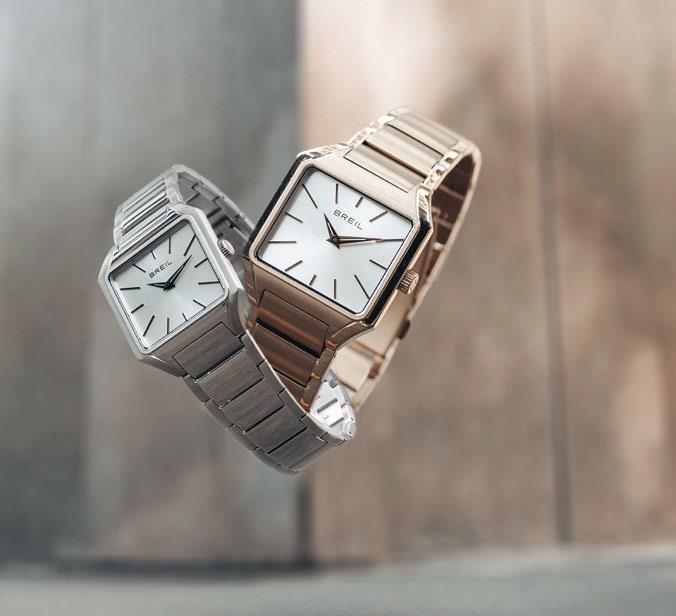
and inputs that come to us from new media and talented young people. Creativity and connection are now crucial drivers to inspire cultural and social renewal. Younger people offer food for thought increasingly often; mediated and processed by the company and its skilled experts, they become fertile ground for growing new concepts applicable to different areas. This is how we came up with the ‘Untouchable Spirit’, which describes a lifestyle, a way of being and thinking according to your own rules, which now pervades the product, style, communication, tone of voice and everything related to Breil, its values and corporate vision”. The same values and vision also apply to jewellery, not just watches. “The decision to create the Breil jewellery range followed a pressing request from the market, and our female consumers in particular, to have other accessory to wear with our watches - Binda explains. The ‘classical’ jewellery known and popular until then did not meet this request. For this reason, we started experimenting and embarking on new journeys, starting from one of the primary features of our watches: the use of steel. No one before Breil had thought of producing steel jewellery, but after the launch of Breil Stones in 2001, the jewellery market has never been the same again”. Even though he grew up among watches, Marcello Binda is therefore
very attached to jewellery: “It will always have a place in my heart because it has allowed me to implement unprecedented experiments and innovations. We were the first to offer steel jewellery, with pieces that can adapt to the wearer’s personality with Snake and transformable jewellery with Bloom. And with our Magnetica System, we can now enhance the concept of modular and transformable jewellery”. These Collections have become icons, such as the watch collections that Binda mentions: “Manta, from 1978 and subsequent years, One from 2001, New One from 2019 and our recent The B from 2021. These were some milestones in style and brand success, as well as innovation and audacity”.
In 2022, Binda Italia looks to the future with the strength of tradition and solid roots in Milan, one of the most vibrant cities in Europe, and one of the world’s most creative countries: “Being an Italian company has allowed us to underline our natural inclination and attention to design and research and a distinctly recognisable style”.

The goal is rocking the next 100 years.


A pilot’s chronograph whose coloured scales make it possible to measure time in other sports too, as if it were a mechanical smartwatch.


The salmon-coloured dial, unusual for a pilot’s watch, makes it an unconventional timepiece. It is also very light thanks to a titanium case and bracelet.
It is inspired by the chronographs made for the British Royal Air Force in the 1970s. The dial’s grained texture is reminiscent of the cockpits of vintage aircraft.

The new version of the ultimate pilot’s watch comes with a stainless steel case, a “racing green” dial, and a matching rubber strap.

Breitling Navitimer B01 Chronograph 70 years after its launch, the collection has been redesigned while maintaining its distinctive features, starting with the famous rotating slide rule.

Classic or colourful, just time or chrono, the aviator’s watch is an alltime must have.Bell & Ross Multimeter Hamilton Khaki Pilot Pioneer Mechanical Chronograph IWC Big Pilot’s Watch 43 Oris ProPilot X Calibre 400

Milano Jewelry Week is back after the two-year stop imposed by the pandemic. Looking at the numbers, this second edition promises to be even more international and crowded than the first. “As far as we are concerned - confirms Enzo Carbone, founder of Prodes Italia, the company that created and organises the Milano Jewelry Week - the stop from Covid was only physical, as we never stopped planning it. These long months have allowed us to design and work on new formats and to develop new relationships”.
With about 200 scheduled events, 500 exhibitors from 40 countries, and more than 8000 jewellery pieces on display, together with a capsule dedicated to watches, anticipating a major event in 2023 - from 20 to 23 October, special flags will ‘invade’ the city centre, placed in front of the participating locations: in addition to jewellery ateliers, goldsmith academies and schools, also art galleries, fashion boutiques, design showrooms and commercial activities of different sectors, where goldsmith masters from all over the world will exhibit their creations in new contexts and scenarios.
The event will be under the patronage of the Municipality of Milan, C.N.A. Federmoda and Club degli Orafi, while confirmed partners include prestigious institutions and names such as Assogemme, Borsa Diamanti d’Italia, Italian Gemological Institute, Associazione Orafa Lombarda, A.N.T.I.C.O. - the Italian National Association for the Protection of the Gold Sector, Assamblage (the Romanian Jewellery Association), The Brian & Barry Building.
The MJW will also involve several jewellery schools, hotbeds of emerging talents, becoming a unique opportunity for dialogue and exchange between Italian institutes (IED and Scuola Orafa Ambrosiana in Milan, Alchimia
Contemporary Jewellery School in Florence, FOR.AL in Valenza) and its counterparts from Romania, Brazil, Singapore, Nigeria, Mexico. The Milanese Galdus will host lectures and workshops open to the public and a talent show featuring the most promising students at the partner schools.
Among group exhibitions, Artistar Jewels is certainly one of the most prominent. Now in its eighth edition, the contemporary jewellery
show will gather over 200 artists and designers at Palazzo Bovara this year. The designers of the winning creations in each category will receive their awards during a spectacular ceremony. Also, the FaB by Artistar Jewels will make its debut at Palazzo dei Giureconsulti this year: 150 independent brands and designers will present jewellery inspired by the 4 natural elements. Alessio Boschi, Brand Ambassador and one of the most famous names in international jewellery, will deliver the prizes to the winning projects.
Another place dear to the Milanese people, La Pelota will host The Jewelry Hub, a B2B and B2C event, where the High, Fine, Fashion and Vintage Jewellery collections created by a hundred international brands can be admired. Another noteworthy debut is that of Jewelry Drops, an exhibition of about 500 jewellery pieces at Palazzo Giureconsulti, one-of-akind or limited editions, made of unusual or recycled materials.
Parallel to the group exhibitions, countless MJW events will feature the likes of Christie’s, Sotheby’s, Antonini Milano, Brian & Barry Building, Scavia, Gioielleria Merzaghi, Veronesi Gioielli among many others. The Milano Jewelry Week jury will include Vanessa Cron, Jewelry Historian, Donatella Zappieri, Jewelry Business Consultant, Gianni De Benedittis with the futuroRemoto award, Guido Solari, Director of the Ambrosiana Goldsmith School and Director of SOA Lab & Factory, Paolo Cesari, President of Assogemme, Azzurra Cesari of Cesari & Rinaldi, and Lucia Massei, Creative Director of Alchimia Contemporary Jewellery School of Florence.
Other awards will include the Borsa Diamanti d’Italia prize and the ASSAMBLAGE Prize with participation in the Romanian Jewelry Week, while partner galleries - Floriano Gallery (Brazil), Babs Art Gallery (Milan), Esh Gallery (Milan), Eleni Marneri Galerie (Greece), Ezüstláz Galéria (Hungary), Sculpture to Wear Gallery (USA, New York) - will select the jewellery to exhibit in their spaces for free throughout the year.

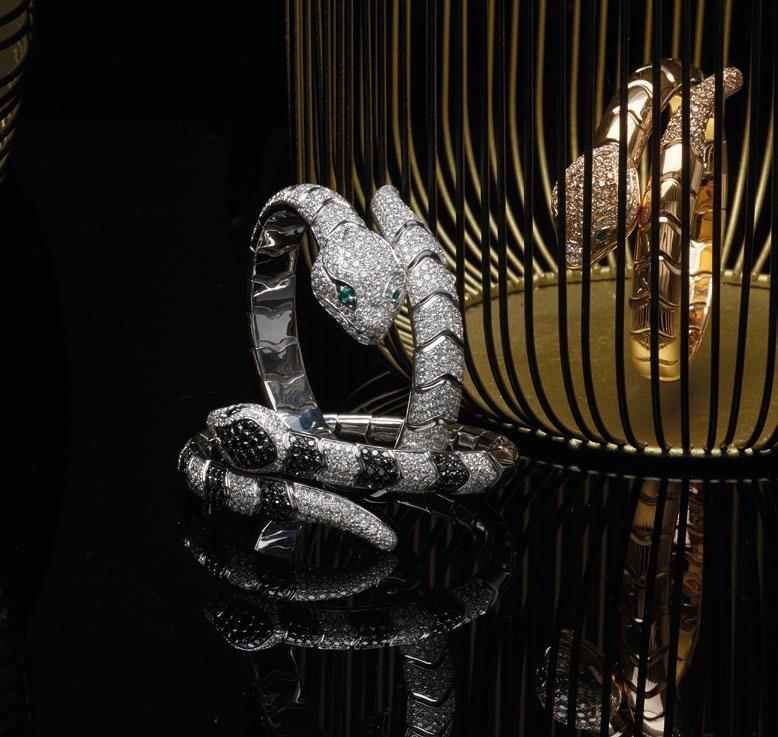









the second floor of the Brian & Barry Building, dedicated to jewelry and watches, will host an exhibition where the brands will be the absolute protagonists. All jewelry manufacturers have been asked to express and describe themselves through a particular piece of jewelry: an earring. They took up this challenge giving life to an artistic path which will lead the visitors to discover the intrinsic characteristics of every jewelry brand present on the floor.
VIA DURINI, 28

 by Rosa Chiesa
by Rosa Chiesa


Residential and contract design spaces welcome pieces inspired by different aesthetics that coexist harmoniously in a collective project.
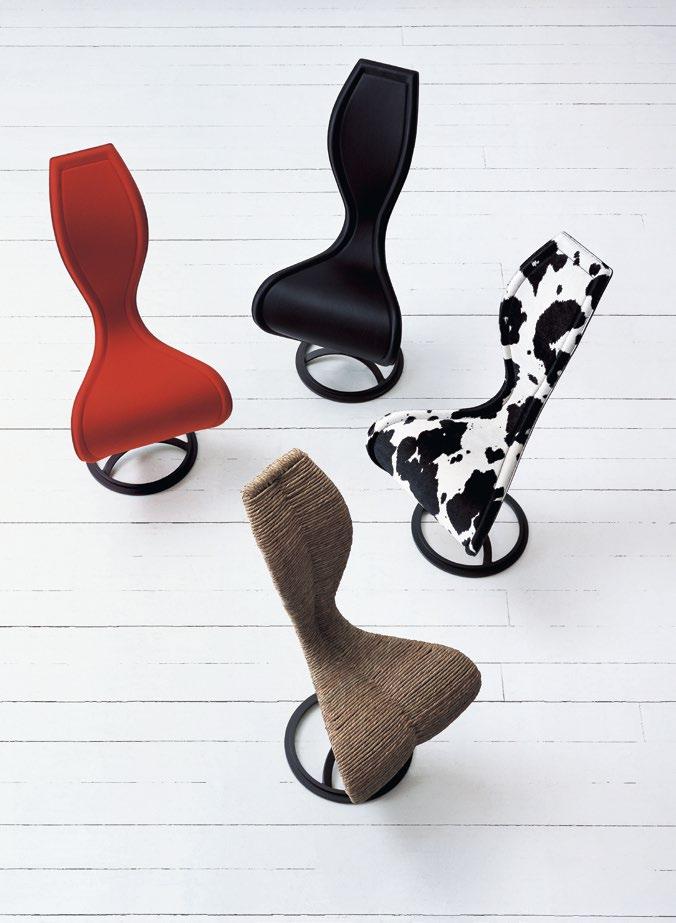
Again during Design Week 2022, the Cappellini company proved its “systemic” approach to envisioning new scenarios with a double contemporary living exhibition by international creatives and by supporting young talented designers, asking them to develop its futuristic concept centred on the parallel dimensions of living.
A furniture company founded in the first postwar period, Cappellini has built a new identity since the 1980s by meeting young international designers - some of whom are now wellknown personalities. He also inaugurated unprecedented ways (more and more explored since then) of presenting products: museums and abandoned ex-factories became a favourite setting for experimental design. As confirmed by the success of projects such as Alcova, the same ‘alienation’ effect obtained by setting contemporary pieces in unusual places works perfectly for a dual purpose: valuing the object’s intrinsic characteristics while rediscovering inaccessible or abandoned sites.
Freedom is a watchword that has guided Cappellini’s production from the very beginning; freedom to experiment, using diverse materials and technologies, while always counting on Giulio Cappellini’s solid expertise, flexibility and entrepreneurial instinct, a typical attribute of historic Made in Italy businesspeople.
Architect and designer Giulio Cappellini has supervised his company’s growth since the late

seventies, orienting it towards a wide-ranging international opening, both by collaborating with emerging designers at the time and by taking care of the company’s image. He defined a corporate image of timeless success and influenced the evolution of design marketing. Famous designers such as Marc Newson, Jasper Morrison, Nendo, Tom Dixon, Marcel Wanders and the Bouroullec brothers are some of the prominent names ‘discovered’ by Giulio Cappellini.
He must also be credited for his remarkable ability to maintain a high level of corporate recognition despite the diversity of languages offered by their catalogue. One of the distinctive features of the company offer is that collaborators have diverse geographical and cultural origins, which translates into a wide variety of concepts and poetics. This was confirmed this year by the presence of famous designers such as Patricia Urquiola, who proposed Lud’ina, a new table and desk version in recycled plastic of the Lud’o Lounge armchair. Noteworthy also Juli Re-Plastic, a sustainable, outdoor version of the successful chair of the same name by Werner Aisslinger (which he created with material from domestic waste, especially packaging), or the take on Elan, the sofa series designed by Jasper Morrison in 1999. Cappellini has represented avant-garde design since the 1990s. Still, perhaps now more than then, his visionary ability has proved crucial in today’s constantly and rapidly
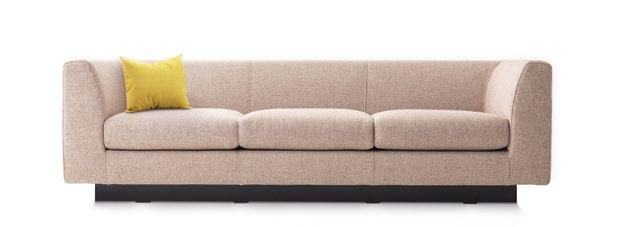



evolving design landscape. Blending design and art and borrowing systems from fashion and entertainment are now standard and highly successful practices to anticipate trends, as exemplified by Cappellini’s “hybrid design” experience.
At the latest Design Week, “Looking to the future” exhibited the new collection at a highly symbolic place for the city, the IBM Studios Pavilion in Piazza Gae Aulenti, a symbol of Milan’s digital evolution. Among the pieces on display, BIG-Bjarke Ingels Group - a Danish design studio with important international offices - featured Big Sofà, a generously sized sofa with a clear architectural inspiration, suitable for the contract market. Belgian newcomer Nik Aelbrecht has designed the essential collection of Openup tables (which cannot fail to evoke the brand’s time-honoured collaboration with AG Fronzoni). Elena Salmistraro, who became famous in recent years, experimented with
glass by designing Miya, a coffee table blending the designer’s inventive creativity with Murano glassmakers’ artistry.
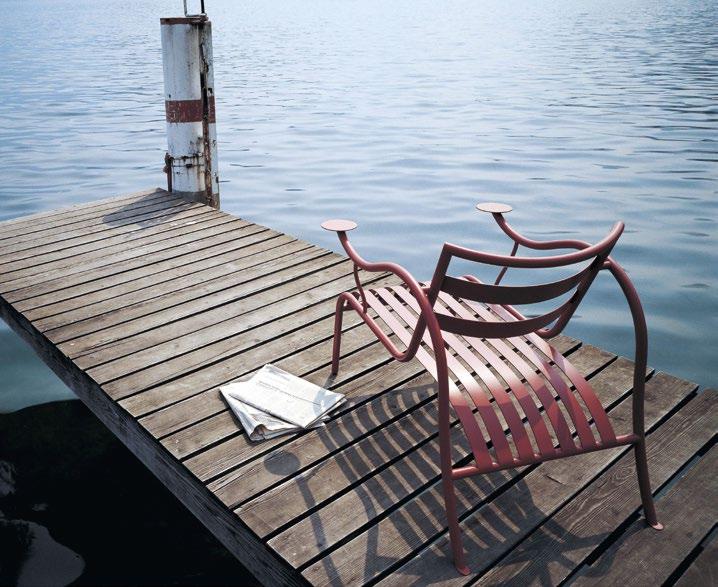
A second exhibition, Cappellini Slowdown Refuge, investigated the theme of living with the growing pervasiveness of technology, displaying historical icons by Shiro Kuramata, Piero Lissoni, Tom Dixon and Mendini, combined with new design proposals.
And to confirm Cappellini’s reputation as a famous talent scout, the Expanded Beauty section was dedicated to the works of students from the Marangoni Design Campus, who imagined the house of the future.
 by Rosa Chiesa
by Rosa Chiesa




Now in its fourth edition, this successful project has leveraged site-specific design and discovered unusual and fascinating spots in the city, giving them back to Milan during Design Week 2022.


Extending design to neighbouring yet distinct areas such as art and craftsmanship is a characteristic feature of recent years (except for the pandemic period). We have witnessed the appearance of increasingly hybrid objects and processes that cross into other methods, far from the traditional industrial design concept.
A varied linguistic panorama, which associates the word ‘design’ with multiple expressive manifestations, is echoed by an equally rich and multifaceted exhibition culminating in the format proposed by Alcova.
Replicating and surpassing the success achieved in 2021, Alcova - a platform founded by Valentina Ciuffi, founder of Studio Vedèt and Joseph Grima, founder of Space Caviar - has chosen a very particular location for the fourth edition of the event. It was held at the Military Hospital Centre of Milan and the annexed urban park, covering 20 hectares.
The event featured design in all forms, from the most experimental/independent ones from schools and academies to more

institutional proposals. Still, it also left room for emerging talented designers engaging in new fields - technological research, social practices and sustainable design.
The ninety projects on display, distributed in four buildings and the outdoor areas, alternated different styles and moods. They included sophisticated interiors by Nicolò Castellini Baldissera, with custom furniture in a domestic space “inhabited” by natureinspired elements (the Portaluppi Herbarium wallpaper by Pictalab hints at Portaluppi’s garden room in the Casa degli Atellani), and the Aditions + Hello Human installation, offering a multifaceted vision of American designers and artists. The Venus lighting collection by Servomuto created evocative atmospheres, the result of research by designer Serena Confalonieri; her work focused on female body curves which, translated into the lamps, were sheathed by a now historic elastic fabric - Lycra. There was also room for collectable design, blending into art with designer pieces and limited editions. Examples include the works by French Cliché, a “nomadic gallery” founded in 2019 by Emily Marant and Hugo Matha with
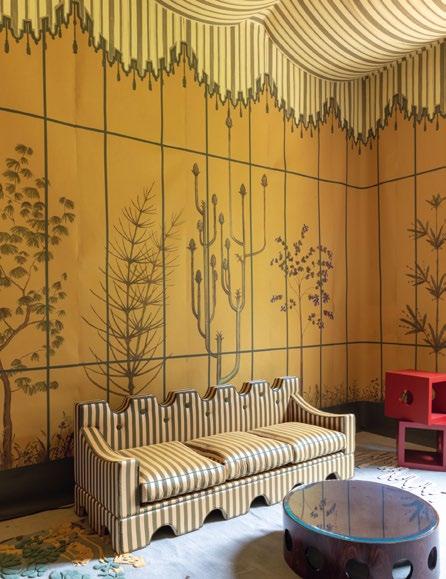
the ambition of reviving French excellence by developing collaboration between young emerging talents and skilled craftsmen. Another area displayed more private collections, such as Dukhan of the Empty Dinner, which explore deep emotions such as the pain of absence and translate them into some sort of mourning through physical pieces. The new Curated by Alcova section featured emerging talents such as Kikie Chudikova, Chinese artist and designer Duyi Han, the Spanish Jorge Penadés and The Back Studio (an Italian-Indian group), founded in 2019 by Eugenio Rossi and Yaazd Contractor among others.
The vast exhibition programme, interspersed with events and talks, appealed again to both insiders and simple visitors, tourists and the Milanese people, who have temporarily re-appropriated spaces that had long been inaccessible. In recent years, the Design Week has increasingly become an opportunity - also and above all for non-specialists - to discover unique buildings, former industrial facilities and places that would be hard to visit in Milan. The design world showed a new way to open its sphere to urban communication, the rediscovery and enhancement of places, promoting the habit and care of the urban environment, which revealed unexpected and vital facets this week.
ADITIONS+HELLO HUMAN
ADITIONS+HELLO HUMAN
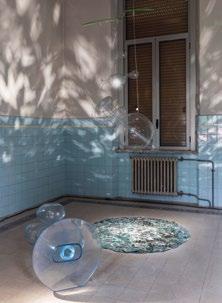

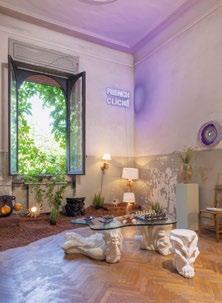



Design goes on stage in all its nuances, art design, limited editions and independent design.FRENCH CLICHÉ


Born in the UK and growing up in the countryside, Emma moved to London, where she still lives and works, to study Fine Art Textiles at Goldsmiths University. After completing her studies she felt she needed to continue her practice but with a new medium and began to study jewellery making at night school. “It was frustrating to begin with but I think it was meant to be as it has allowed me to properly engage with the issues of body and object, how we interact and the meanings we create and perform” she explains. Emma’s pieces - which she personally designs and makes - give expression not only to ideas or commitments but also to something beyond the individual or society, something that contains a spiritual dimension, mystery, magic. By means of traditional metalworking techniques, Emma works from flat silver sheet piecing forms together. Over time her technique has evolved: “I have discovered a way of elaborating these basic forms with moving elements thereby adding further layers of meaning and giving a very tactile, playful experience to the pieces”. Emma often uses the remains of materials from one piece to make the next. The shape of an offcut may be added into another piece while the remains of dust may transform themselves into components of new pieces. “ Ultimately, I aim to create a sculptural object which encapsulates the themes that went into making it. Not for these to be immediate, more like whispers to provoke thought and emotion”. Emma’ s latest collection, called ‘Women’s Words’, explores the theme of language and its impact on woman. She will exhibit at Milan Jewelry Week this October. Her work can be purchased through her website and the OVERJEWELS platform.




For the past 47 years, Gloria Bass has been carving and coiling her way through the jewelry industry while developing her own unique style and brand of handcrafted jewelry. After having perfected her tradecraft signature gold coil work that adorns many of her creations, Gloria focused on creating timeless jewelry for generations to come. Gloria’s passion for craftsmanship and details is what first sparked her interest in the jewelry world, and after having studied abroad and apprenticed in the old-fashioned European method of jewelry making, she set out to create artistic pieces wherein European stylings would be showcased with a contemporary look while still paying tribute the ancient goldsmithing craftsmanship. When Gloria creates custom jewelry for her clients, there is nothing standard about any of her creations: each piece is custom tailored to suit the style and the personality of the client to ensure that the product is a physical expression of the wearer themselves. Whether the inspiration is born from the brilliance of a single stone or from the simplicity of everyday life, Gloria Bass Design guarantees in-house handcrafted jewelry, using only the finest materials and stones, to ensure that every piece produced is as memorable and special as the idea behind it.





Past and future live together in Juntao Asa Ouyang creations, a mix of crafts, designs and modern technologies that become jewelry pieces. The designer, winner of the prestigious Winterson Prize in 2019, takes inspiration from daily devices and technologies to make different kinds of wearable pieces that interact with the bodies. She uses both traditional and modern technology, combining traditional lacquer techniques with 3D modeling.
“I design for everyone who lives nowadays, whether they like or dislike digital life, prefer upcycling or rejuvenation. My design can explore these two attitudes at the same time and I think a piece of jewellery should express a small piece of history and also communicate the recent ways of wearing”. Nowadays Juntao is focused on bespoke pieces created specifically according to the requests received and she is planning to expand her precious art towards an ever greater production.

“I took these last two years as a chance to talk to myself and study more and more in order to find my way in the jewelry world”.


Orogami is an Italian producer of exceptionally crafted fine jewellery based in Orvieto, Italy. Massimo and Tiziana Aloisio established Orogami in 1990 after more than ten years of design experience working with well-known brands throughout Italy and France. Their personal and professional life together began on a flight that he tried to avoid taking and on which she was not supposed to be. They were seated next to each other and their first conversation was about gold and design. The couple were both born and raised in Rome. After completing their university studies, they worked in the fields of art and architecture. During these years, they had enriching experiences, learned the secrets of the trade from some of the most renowned goldsmiths in Rome and traveled extensively, giving them a wider perspective of different cultures and artistic expressions that deepened their personal point of view about jewellery design and life. Years later, they would apply this knowledge to their original style of jewellery making. When it finally came time to choose a name for their company, they wanted it to be something that would evoke their blessed encounter.
“Orogami” may sound like the Japanese art of paper folding, but it’s actually a composition of “Oro”, the Italian word for gold and “gamos”, the ancient Greek word meaning wedding. Orogami: Union in gold. It was perfect. Furthermore Orogami read backwards give Imagoro, a Japanese word that means “ about this time” and this is the underlying philosophy that Massimo and Tiziana put in their collections. In 1994, the couple moved to nearby Orvieto, an ancient city with more than 3,000 years of history located
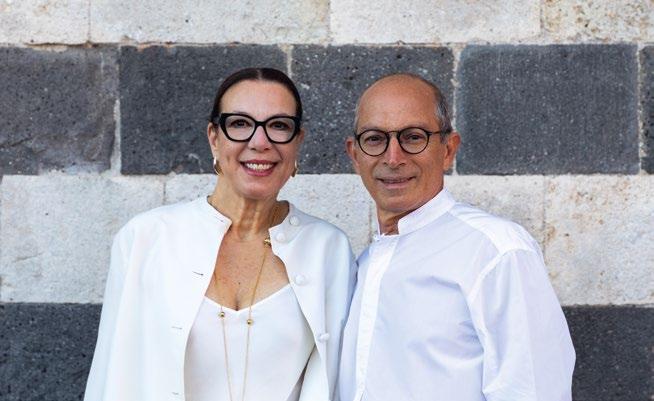
in Umbria, the green heart of Italy. It was in Orvieto that they found renewed inspiration and a better quality of life.
Orogami and its founders’ path to creativity is reflected in their design philosophy. It’s this distinctive approach to contemporary design that allows Orogami to merge aesthetics, high- quality craftsmanship, versatility with primordial symbolic value into its collections. Through each collection they seek to express and share ideas about life and its emotions. The creative journey begins with an idea a concept that wants to be expressed that is then transformed in a form that expresses at its best.
The play of chiaroscuro, the use of different tonalities of gold with the chromatic use of gems and the life’s iconic motif with circles makes Orogami’s jewelry recognizable and a perfect representation of the secrets of traditional Italian artisan energies and spirit. Together these elements identify its unique and distinctive creative process that results in finely crafted jewelry renowned among a distinguished and loyal international clientele.


Orogami exhibits regularly in art galleries, shows, events or prestigious jewelers in different countries. Over the years they have been appointed with several design’s awards, an Industry Leader Award by the Santa Fe Simposium and appointed as Rising Star at the Design Centre Selection of the JCK Show in Las Vegas.
 BUBBLES SILVER COLLECTION
BUBBLES SILVER COLLECTION
After an experience in Valenza as a model maker of Boucheron jewellery, Elisa Pozza decided to embark on her path by founding the Petronilla brand in 2006. The name, which takes inspiration from a Roman matron who loved to make jewellery, means “little treasure” and perfectly represents the brand’s creations: small precious items in gold and platinum, enriched with precious and semi-precious stones, gems and South Sea pearls. The work done for Boucheron in the early years of her career inevitably influenced even Elisa’s most contemporary creations. “My first role was as model maker for the Maison’s animals. Today animals, and the world of nature in general, continue to inspire my collections. Through them, I can convey sometimes indescribable feelings”.



Since 2017 the brand has been present on the online windows of 1stDibs, Etsy and Rubylane. Online sales, together with the contacts and relationships established through her Instagram page, have allowed Petronilla to face the challenging period of the pandemic by targeting customers from all over the world through the digital universe.



Growing up with art in his family, Colby Shelton Byrd started his journey towards jewelry thanks to a dynamic mix of his grandmother’s paintings and sculptures, his mother’s interior design projects and 80’s inspired mixed media paper earrings, and his father’s love of the sea and never ending work ethic. “My family has inspired me since I could remember but it was during college and self discovery that I found my passion for jewelry. So I focused my studies on the basics of art and sculpture, where I had more creative freedom”.After spending several months in Italy for an art program, Colby was able to bring home the inspiration and skills needed to begin his own journey in 2013 with the brand Shelton Metal. Many of his designs are inspired by the depths of the sea; treasures that hold integrity to their origins, whether they are recycled heirlooms or new sustainably sourced materials. His techniques are raw, minimal and organic with a true custom touch to each element. Many of his creations are hand carved and cast with inlaid gems or hand manufactured and forged using recycled gold. “I hope to always tell a story or evoke a feeling with every treasure I create. A single ring can travel the edges of the World, represent a love deeper than the sea or the memories of a lost soul. No matter what the emotion, it’s my passion to capture it within every last detail”. Shelton Metal, that will attend The FaB during MJW in October with the new Mare di Tesoro collection, is distributed in limited and well curated small retailers and also online (www.sheltonmetal.com). “I hope to continue to build a legacy with my jewelry. To expand and continue this journey internationally with more exhibitions and collaborations”.

 Photographer: Billy Logan Tudor | Model: Emery Castor
Photographer: Billy Logan Tudor | Model: Emery Castor

Binliang Alexander is a French jeweler of Chinese origin. He has been interested in gemstones since a very young age. Art being his great passion, during his years of study at the National School of Fine Arts in Lyon, he began painting and realizing sculptures and photographs. At the same time he began making pieces of jewellery as a self-taught craftsman, for his own pleasure, because he simply couldn’t find anywhere unisex jewelry to his taste. His growing passion and unquenchable curiosity for the world of jewelry led him to study at the prestigious Parisian schools of Haute École de Joaillerie and École Boulle. In 2020 Binliang Alexander launched his eponymous jewelry brand. His vision and creative philosophy have been deeply influenced by the great cultures of his family - French and Chinese - and his sources of inspiration can be found everywhere: a stone, a poem, a feeling, an encounter”. Creativity is for me a tool of communication and a source of happiness”. In his atelier - located in the very famous Place Vendôme, Paris - he creates bespoke jewelry and every piece is completely hand made, from the wax sculpting or the metal smithing to the finishing. He also creates beautiful pieces upon request, working together with the customer, understanding and satisfying his desires and realizing his dreams because, as he states, “Every moment in life is unique, just as my jewelry is!”.




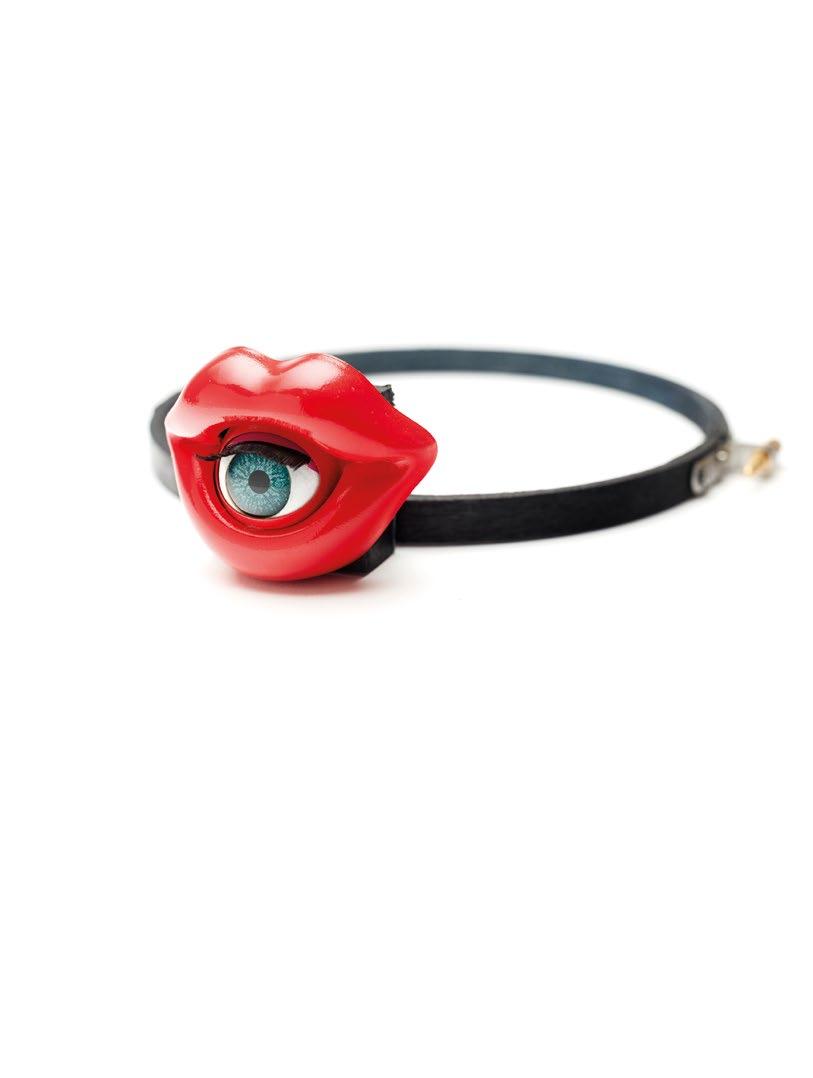 by Antonella Garello
by Antonella Garello

With its shameful numbers (annually: 0.5 million tons of synthetic fibres poured into the sea, 79 billion cubic metres of water consumed, 10% of the world’s total greenhouse gases emissions, 660,000 tons of municipal waste against negligible percentages of garments recycled as clothing), the textile-clothing sector remains among the least sustainable in the world. The European Commission imposed a change on March 30, outlining the Strategy for Sustainable and Circular Textiles. They have set a series of objectives for 2030 to decouple supply chain growth and profitability from waste growth. Anticipating the legal obligations to come, Sistema Moda Italia, the Italian textile-clothing association of Confindustria Moda (which includes its homologous associations Assocalzaturifici and Assopellettieri), has launched the Retex.Green consortium. Mauro Chezzi, SMI deputy director and head of the initiative, talked to us about it.
What are the obligations set for manufacturers by the European Strategy for sustainable and circular textile products?
Textile-clothing manufacturers are required to get the tools to become more resilient and competitive even in the long term; they must improve performance in terms of sustainability. By 2030, textile products placed on the EU market must be as durable, repairable and recyclable as possible. As well as respecting social rights, they must be made as much as possible of recycled fibres and be free of hazardous substances. In developing a more circular supply chain, waste management becomes crucial. One of the main tools has been identified by the European Commission in the Extended Producer Responsibility (EPR) policy. Unlike what happens today, manufacturers will have to deal with their products even after their end of life, taking care of textile waste collection and management.
Why was Retex.Green created?
The consortium was created to enable manufacturers to manage these new obligations by transferring them to the consortium. In short, manufacturers will be able to transfer the obligations deriving from the new legislation to the consortium by registering with it and paying an eco-contribution, which is the amount needed to finance the waste management system. We have worked in advance to help companies be ready when the obligation is effective - we think by mid-2023. And we thought systemically, involving textile-clothing products, footwear and leather accessories, which are a large part of fashion.
Will manufacturers also be able to fulfil their obligations independently?
The legislation will certainly provide for individual EPR systems, but I would say that these are within reach of companies with
large quantities of products on the market, the likes of Zara or H&M. For everyone else, individual management will be virtually impossible. It is about managing the waste collection, sanitisation, selection and treatment processes throughout the national territory on a pro-rata basis - that is, a proportionate allocation as a percentage of the waste placed on the market. The trend is to promote use and recycling rather than waste-to-energy and landfills, which are considered residual in the new EPR system. The top of the internationally recognised waste hierarchy is the priority of avoiding waste production; then comes reuse and recycling, and at the bottom are waste-toenergy and landfill. Managing all these activities at a national level involves really high costs and expertise that companies do not have.
More specifically, what tools will companies have to equip themselves with?
The new rules will require a new organisation. Just think of the radical change of adding an accounting system that does not consider turnover or product price, as happens now, and not even garments or pairs. In waste management procedures, the key driver is mass and weight, so companies will have to start thinking of a jacket as a specific amount of grams of material they will have to manage at the end of life. The consortium will, of course, take care of all the members’ legal obligations.

Apart from operational issues, how else will Retex.Green support companies through this change?
One of the consortium’s planned actions is to support companies in developing an eco-design. That is, it will help them align with the circular economy paradigm from the beginning of the design process, helping them think about a product’s possible post-end-of-life destination in terms of recyclability and reusability.
From the beginning, that will mean thinking about demanufacturing, the simple breakdown of individual textile or non-textile components. This type of design process is absolutely in line with what is required by the EU.
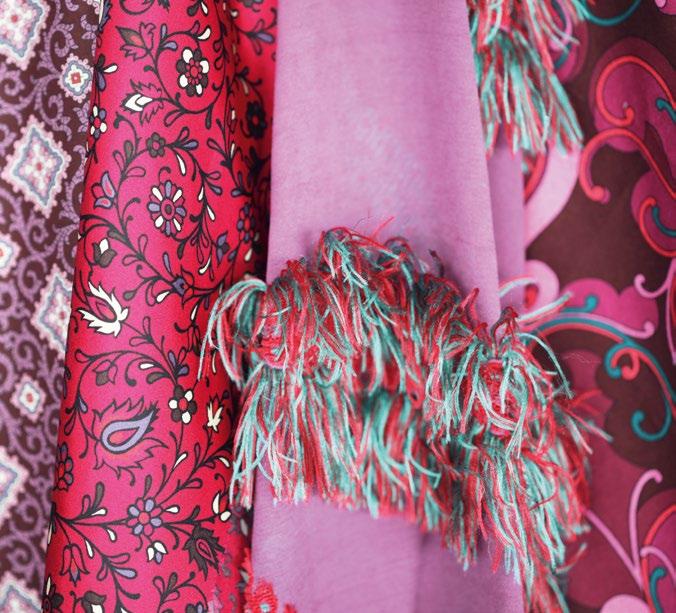
The strategy developed by the European Commission envisages the presence of several consortia competing against each other. Isn’t there a risk of improvisations or, worse, of illegal situations?
In choosing which consortium to join, in addition to the services provided, manufacturers must surely pay great attention to the issue of legality to avoid nasty surprises. Retex.Green has adopted strict legality and transparency protocols for complete traceability. We were happy with the positive feedback from the bicameral parliamentary commission on ecomafias for our work programme. Also, unlike other consortia, this consortium is exclusively for manufacturing companies in the supply chain - whether they are SMI members or notand not for operators in the waste management
chain. Although very important, opening the consortium to our possible suppliers would risk creating conflicts of interest.
How will consumers be involved and informed?
The European Commission circular economy package includes, among other things, the Digital Product Passport, enabling comprehensive product tracking. For example, it describes what parts of the product have already been recycled and are included as recycled fibre or recycled parts, and what has been done to make it recyclable or reusable at the end of its life. Then there will be commercial initiatives with stamps or labels. Our trademark, registered as a European collective trademark, will allow companies to tell consumers that they are part of the Retex.Green community, concretely and objectively focusing on eco-design and recycling-reuse.


 ©Marcello Geppetti Media Company
©Marcello Geppetti Media Company
This technology will disrupt our existence and is a market with enormous potential for some; in contrast, it is a game for its own sake and a speculative bubble that will deflate sooner rather than later for others. However you think about it, the phenomenon cannot be ignored (the futuristic Quantum was finally auctioned at Sotheby’s last year for 1.4 million dollars!). To try and outline its substance and proportions, we talked about it with Achille Minerva, co-founder of ItaliaNFT with Marco Capria, the first marketplace dedicated to NFTs linked with Made in Italy excellences. At the end of June, StartupItalia selected ItaliaNft among the 5 most promising Italian startups in the NFT and Metaverse fields. ItaliaNFT has been talked about recently for creating NFTs for the Giro d’Italia’s Trofeo Senza Fine and the iconic photograph of Liz Taylor and Richard Burton kissing, snapped by Marcello Geppetti in 1962.
Let’s start from the beginning. What exactly are we talking about when we say NFT?
The first step to understanding an NFT is understanding what a blockchain is. To simplify, we can define a blockchain as a digital public ledger that is not managed by any central unit or body but distributed over a series of networks, computers and servers located worldwide. A whole range of information and data are recorded in this “database”, including transactions involving digital objects. Any data in the register is visible to all and cannot be changed without the network’s consent. In practice, it is an inviolable, unchangeable register.
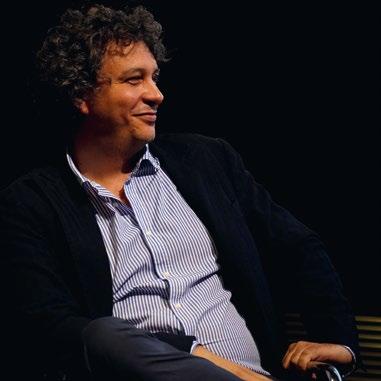
NFTs have aroused heated debate between passionate supporters and caustic critics since their appearance (it was 2014 when New York artist Kevin McKoy stored in a blockchain his work Quantum , an octagon-shaped animation that continuously took on new forms).
When we talk about NFT, an acronym for NonFungible Token, we are talking about a unique token, which identifies and certifies any digital asset to which it refers. Any photo, image, video or text found on the Internet can be associated with a unique token. generated - in jargon, minted - on the blockchain. Minting this token on the blockchain creates the so-called ‘digital scarcity’, i.e. being able to associate an asset to a reference token that certifies its ownership. It is a disruptive innovation because it makes it possible for the first time to attribute ownership of a digital asset, which can be proved through this ‘ownership certificate’ on the blockchain.
Any digital product can be replicated, while, for example, the Mona Lisa is unique and unrepeatable. Where does the concept of uniqueness and rarity lie in a file?

This is another critical point. You can replicate a file, just as you can replicate the Mona Lisa. Prints, drawings, lithographs, and posters of Leonardo’s masterpiece exist and are sold worldwide, but the original is always kept in the Louvre. The concept for NFTs is the same: a token can only be associated with a specific file, which belongs exclusively to that token’s owner and their wallet; the owner is the only one who can resell it to third parties. So, I can replicate the related asset, but I will never be able to sell the property.
Are NFTs bought and sold exclusively through auctions and cryptocurrencies?
Not necessarily. On our ItaliaNFT platform, for example, we also allow visitors to buy through the so-called Buy now system: in this case, the customer enters and purchases for a fixed price. Also - unlike many other marketplaces - we also provide the option to buy with credit cards.

How do you ensure that an NFT remains usable despite the rapid changes in new technologies?
These tokens can store metadata, including files (as said before: videos, images, texts…), in a specific format called IPFS, which stands for Interplanetary File System. Technically, this format is not part of the blockchain for now because the operation would be too “heavy” in terms of space. So you add the link that refers to this IPFS, an “interplanetary” file distributed on millions and millions of servers worldwide. This eliminates the corruption problem: if one server goes down, there are still millions of others.
So NFT certifications are confined to the digital world?
Not really. An NFT can certify a digital asset’s ownership, but also a series of data or physical objects. Think about a piece of jewellery or a watch; all the characteristics of that specific item, if written on paper, could get lost or deteriorate sooner or later, but it is impossible
if they are “fixed” in the blockchain in the form of an NFT. And there’s more to it: in the blockchain, small and medium-sized businesses that may not have big budgets can create NFTs that certify their drawings, technical and industrial prototypes, and even patents that bypass the patent issued by the relevant institute. At the moment, the blockchain has no legal value, but in case of disputes, I would still be able to say that in year X on day X at time X, I added this file to the blockchain, so it comes before any other reproduction. It is a hot topic in the industry.
Legality is another highly debated issue. Once you understand that an NFT is a technology, an incorruptible and inviolable ownership enabler, applicable to any digital or physical product, then you also know the benefits it can bring. We are already wondering whether our identities can also be certified by NFTs in the future. Speaking of legality… when live streaming services appeared, there was talk of piracy, a slap in the face of the music industry and copyright. In reality, illegal activities have been duly fought, but the technology has remained, so much so that the music and broadcasting industries now rely heavily on streaming, which is a winning, fast, and efficient technology. The same is happening today.
The Taylor-Burton kiss photo was already a recognised masterpiece. Where is the
added value of its NFT?
The historical importance remains in all its value. It was the last day of the filming of Cleopatra; they were the two most famous stars in Hollywood, there were rumours of a relationship between them, and that was their first public kiss, photographed by Geppetti. But we did something new. Using the morphing technique, we combined many photos taken in sequence: a video appears on the auction site where the two stars meet and kiss. It is also a digital unicum because it has been transferred to the blockchain. While it is true that anything can be transformed into NFT, it is also true that not all NFTs have equal dignity and raison d’être. Had this picture been taken as it was and turned into NFT, it wouldn’t have the same impact. There wouldn’t have been all the great computer graphics work that led to this unreleased video.
The real point is to understand what will remain of this innovation. According to us ‘believers’, if we do not start from an intrinsic value - an event, a historical document, a great brand, and so on - the NFT will have no following, no real recognition. Then the execution makes all the difference: in our digital age, young people, in particular, want to see beautiful things in the digital space. We must not think it is enough to copy and paste some good physical work into an NFT to make something of value;

specific rules are being defined. An NFT is the result of complex work that involves various professionals: a craft designer, a 3D artist, a sketcher… and then technical experts who take care of all the processes leading to the token’s creation and its storage in the blockchain. It is no coincidence that our platform does not give users the possibility, as other platforms do, to upload their NFTs. There is an upstream quality control system to protect all the players involved and ensure that only quality works are submitted.
According to several reports, the NFT buyer is mainly male and is 20 to 35 years old. Asian countries buy more NFTs. China (even though it has banned cryptocurrencies), Singapore, Hong Kong, etc. Partly because those who buy are still very close to the gaming sector - and Asia has a robust number of gamers - and partly because countries like China have always been at the forefront of technology.
In the face of so many very young buyers, can scepticism for NFTs also be an agerelated factor?
Partly, maybe. But any innovative, disruptive technology had a hard time before it was accepted. At the end of the 1990s, press articles declared that the Internet was dead. In more recent years, online marketplaces were predicted an uncertain future because people would never lose the pleasure of making physical purchases in stores; in the dawn of the Internet, some shook their heads in front of emails. In the face of so much scepticism about the blockchain, however, I can see that important multinationals are starting to adopt it because it optimises a whole series of processes.
An NFT is often sold with its tangible counterpart or, in any case, together with physical objects. Isn’t that a limit?
It is true that many users still struggle to perceive an item’s digital value alone, and to understand that, because it is rare, an
NFT enables rare experiences. For example, whoever bought our Senza Fine trophy NFT also received the 4 original Giro physical jerseys signed by the winners. But this is the beginning of a journey; the more we go digital, the more we will come into contact with the Metaverse, a new dimension impossible to ignore.
The sales of NFTs in the first half of the year decreased compared to the same period in 2021. According to some, the bubble has started to deflate.
Like cryptocurrencies, the world of NFTs was also affected by mere speculation, especially at the beginning. I see the reduction in trading volumes primarily as riddance of elements that have polluted real trade until now. However, I’d like to point out that according to Citi, the Metaverse may reach a turnover of 13 trillion dollars by 2030.
 Luna Berlusconi
Luna Berlusconi
*Event dates are subject to change or cancellation. Please check the status of your event in the website.
JIS - Jewelers International Showcase
Miami Beach, 30 September / 3 October
Info: jisshow.com
Luxe Pack
Monaco, 3/5 October
Info: luxepackmonaco.com
Watch & Jewellery
Middle East Show Sharjah
Sharjah, 5/9 October
Info: mideastjewellery.com
Istanbul Jewelry Show
Istanbul, 6/9 October
Info: istanbuljewelryshow.com
Milano Jewelry Week
Milan, 20/23 October
Info: milanojewelryweek.com
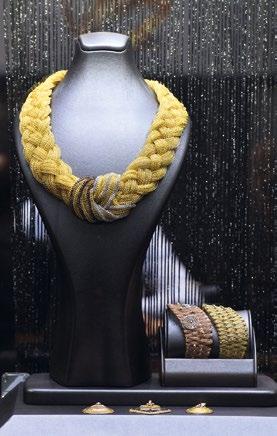
JA New York
New York, 23/25 October
Info: ja-newyork.com
Jewellery Salon Riyadh
Riyadh, 1/5 November
Info: jewellerysalon.com

Kosmima
Thessaloniki, 5/7 November
Info: kosmima.helexpo.gr
JWS - Jewellery & Watch Show
Abu Dhabi, 9/13 November
Info: jws.ae
MIJF - Malaysia International Jewellery fair
Kuala Lumpur, 11/14 November
Info: mijf.com.my
JOGS Show
Palm Springs, 18/21 November
Info: jogsshow.com
Jewellery Arabia
Bahrain, 22/26 November
Info: jewelleryarabia.com
HKJMA - Hong Kong Jewelry Manufacturers’ Association
Hong Kong, 24/27 November
Info: jewelry.org.hk



Kunsthistorisches Museum
20 September 2022 / 8 January
2023
Idols and Rivals. Artists in Competition
khm.at
Large Palaestra, Pompeii Arch. Sites
Until 15 January
2023
Art and Sensuality in the Houses of Pompei



pompeiisites.org
Palazzo Grassi
Until
8 January 2023
Marlene Dumas. Open-End palazzograssi.it
Fondazione Palazzo Strozzi
22 September 2022
/ 22 January 2023
Olafur Eliasson palazzostrozzi.org
Museo Nacional ThyssenBornemisza
11 October 2022 / 15 January 2023
Picasso and Chanel museothyssen.org
Museum Barberini
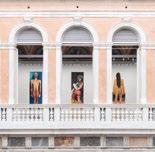
22 October 2022 / 29 January 2023
Surrealism and Magic: Enchanted Modernity

museum-barberini.de

The Queen’s Gallery, Buckingham Palace
Until 26 February 2023
Japan: Courts and Culture rct.uk

Various locations
24 September 2022 - 2 April 2023
58th Carnegie International
cmoa-org
Pinakothek der Moderne

25 November 2022 / 12 March 2023
Max Beckmann. Departure
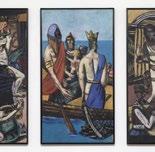
Palazzo Bonaparte
pinakothek-der-moderne.de
8 October 2022 / 26 March 2023
Van Gogh
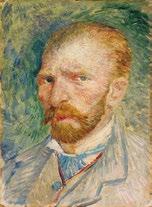
mostrepalazzobonaparte.it
Groninger Museum
3 December 2022 / 7 May 2023
Gianni Versace. Retrospective groningermuseum.nl

The V&A
24 September 2022 - 25 June 2023
Hallyu! The Korean Wave vam.ac.uk

